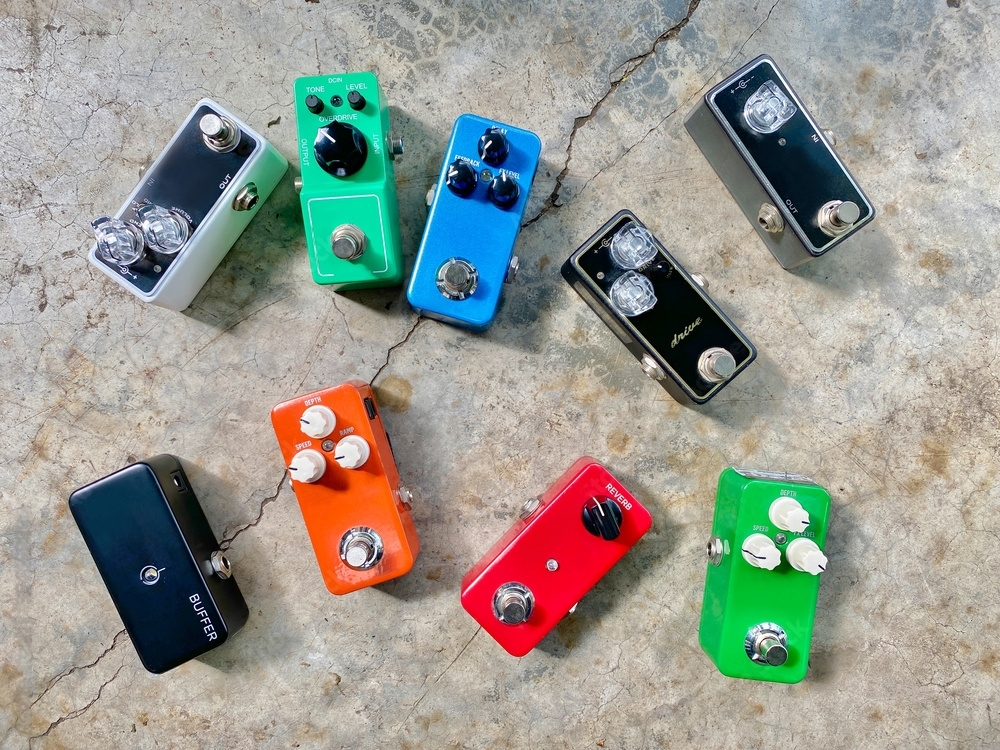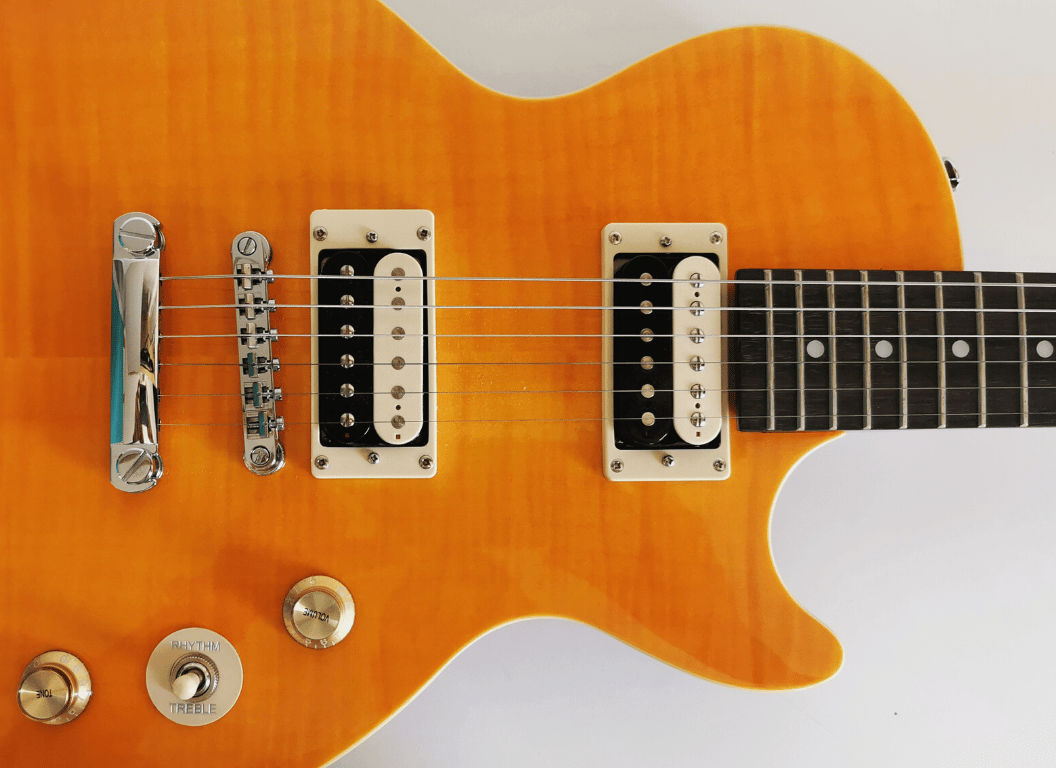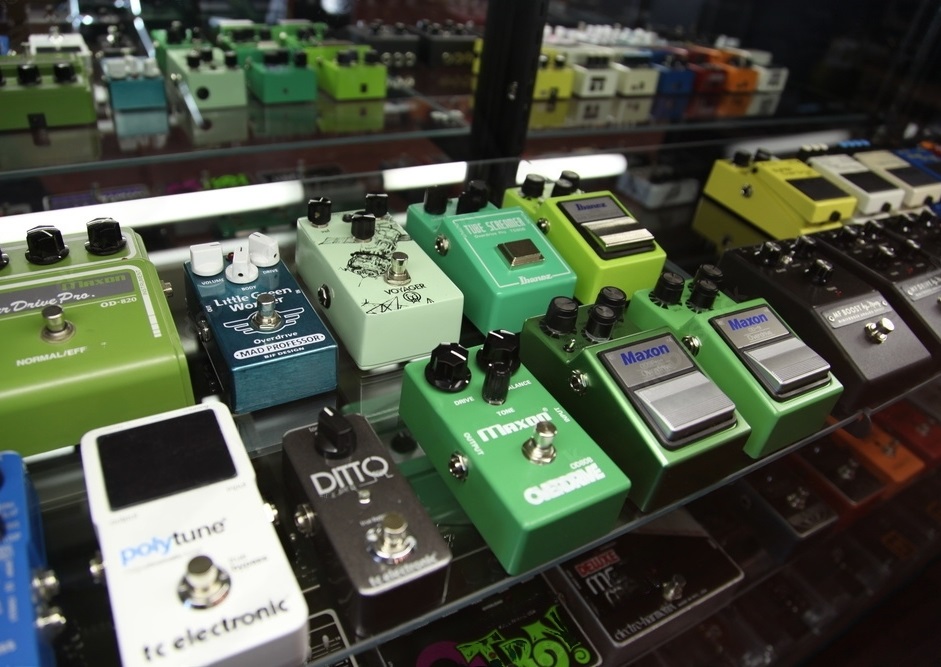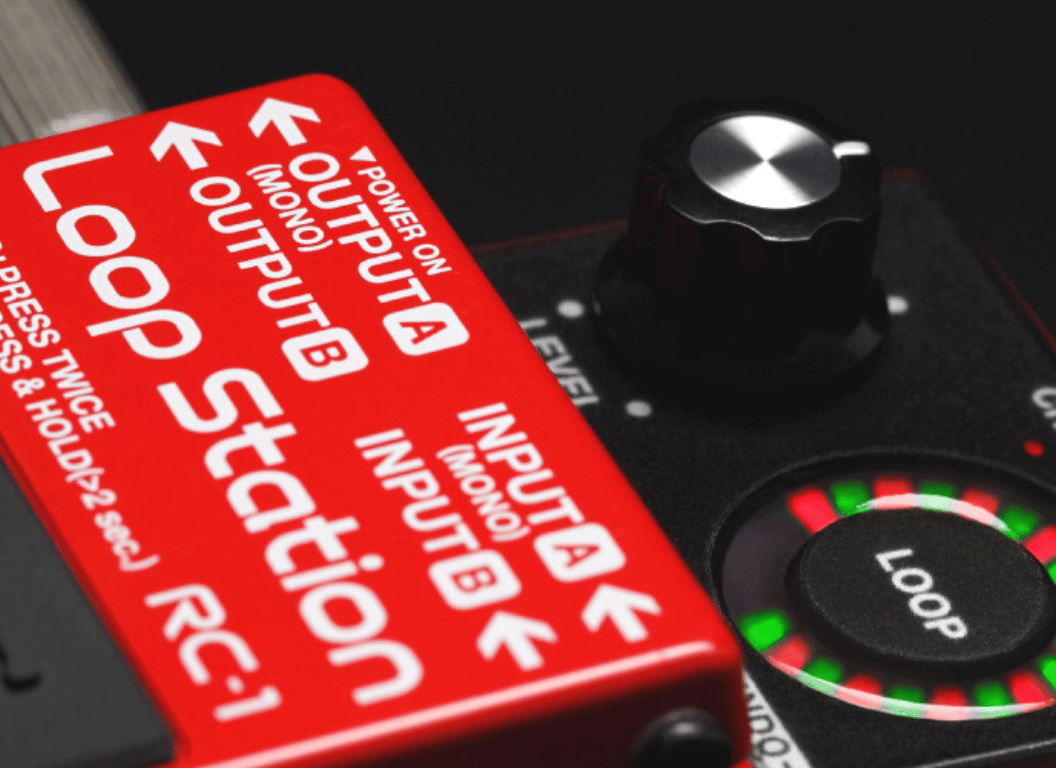Sometimes, all it takes to take your sound to the next level, is a great mini-guitar pedal.
These compact wonders pack a punch regarding tonal flexibility and portability, but with so many options available, how do you find the perfect one?
Fret not, this article will be your ultimate guide to help you navigate and find the ideal mini pedal for your musical endeavors.
From creating mind-blowing soundscapes to achieving the perfect stompbox-style overdrive, we’ll delve into the top contenders in the market, analyzing their features and showcasing their unique capabilities.
Whether you’re a seasoned pro or just starting, the information in this article aims to enlighten and entertain, culminating in you finding the perfect mini pedal for your sonic needs.
Table of Contents
- Best Mini Guitar Pedals
- MXR Timmy Overdrive Guitar Effects Pedal
- Ibanez Tube Screamer Mini Pedal
- Jim Dunlop Mini Wah Pedal
- MOOER E7 Synth Micro Pedal
- Dunlop FFM3 Jimi Hendrix Fuzz Face Mini Distortion Pedal
- Ibanez Mini Chorus Guitar Pedal
- Xotic EP Booster Mini EQ Effect Pedal
- Wampler Mini Faux Spring Reverb Pedal
- Tone City Tape Machine Delay A Mighty Mini Pedal
- MXR Dyna Comp Mini Compressor Pedal
- Nobels ODR-Mini Overdrive Pedal
- TC Electronic Electric Guitar Pedal
- Wampler Plexi Drive Mini Overdrive Pedal
- TC Electronic VORTEX Mini Flanger Pedal
- Wampler Tumnus V2 Overdrive & Boost Pedal
- MXR Phase 95 Mini Guitar Effects Pedal
- Pigtronix PTM Guitar Compression Pedal
- MXR Carbon Copy Mini Analog Delay Pedal
- JHS Mini Foot Fuzz Effects Pedal
- MXR Duke of Tone Overdrive Pedal
- What exactly is a mini guitar pedal?
- What should you consider when choosing a mini guitar pedal?
- Do mini guitar pedals compromise on sound quality?
- How to order pedals on a pedalboard?
- Boutique vs. Mass-Produced pedals
- How much should you spend on a guitar pedal?
- Can you use a guitar pedal with a bass guitar?
- How to properly power your pedals?
Best Mini Guitar Pedals
Before I begin, here are my top selected choices:
Ibanez Tube Screamer Mini Pedal

Legendary tone in a mini-pedal – Ibanez Tube Screamer Mini. Check Price
|
|
MOOER E7 Synth Micro Pedal

Transform guitar into synthesizer with MOOER E7 Synth Pedal. Check Price
|
MXR Timmy Overdrive Guitar Effects Pedal
Professional-grade, sweet, harmonic breakup with dynamic response.
The MXR Timmy Overdrive offers three clipping styles, cut-only Bass and Treble controls, and LF353 op-amp for a wide range of tones in a mini housing. Perfect for guitar players who want harmonic breakup that responds to their playing dynamics.
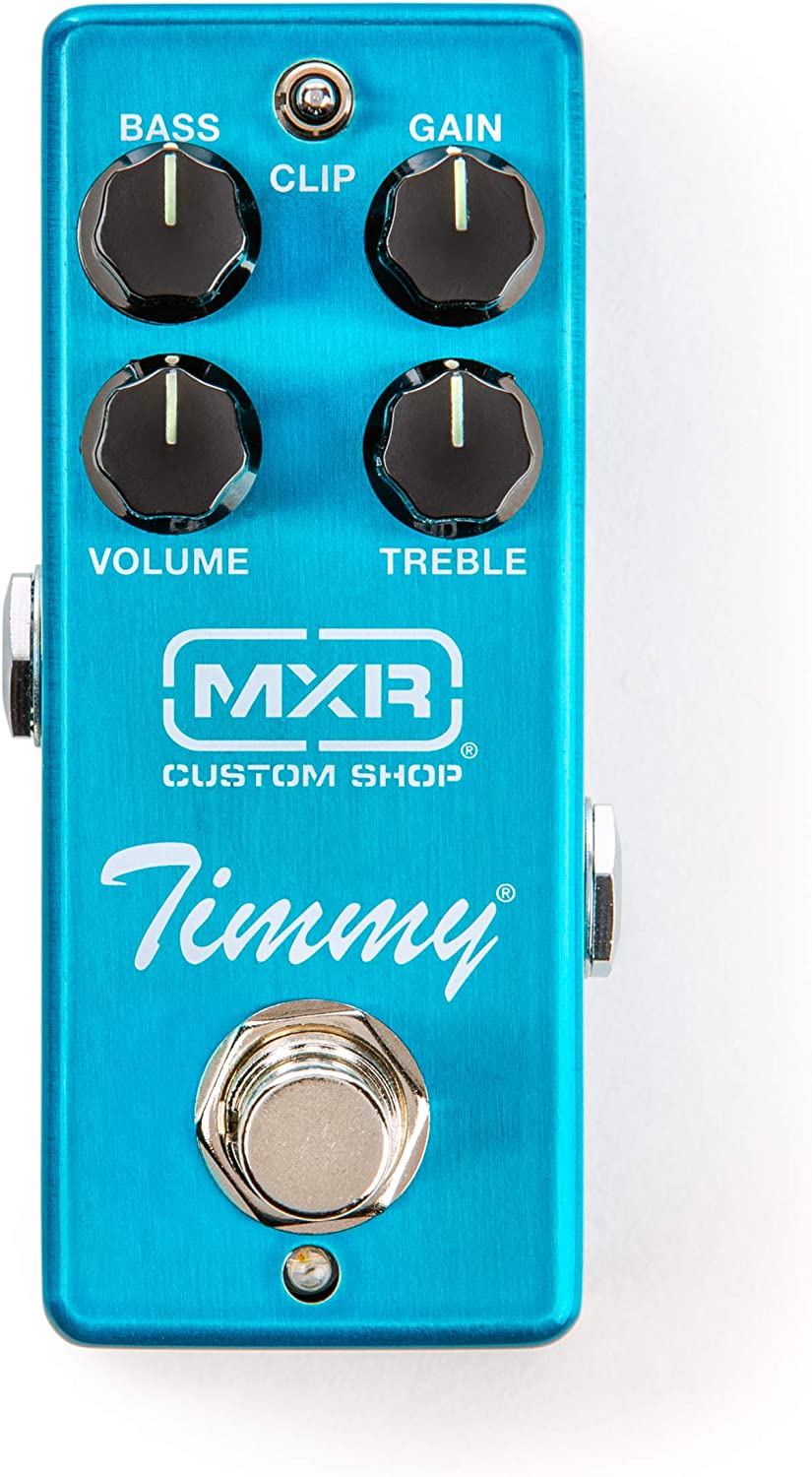
Crafted in partnership with esteemed Nashville pedal creator Paul Cochrane, the MXR Timmy Overdrive Guitar Effects Pedal is an innovative piece of equipment designed to fit into a mini housing, ensuring your pedalboard stays spacious.
Tailored for variety, this device lets you access an expansive spectrum of overdrive tones while retaining the fundamental essence of your guitar setup.
For players seeking versatility, there’s an option to pick from three distinct clipping styles suitable for different playing environments.
What sets this pedal apart is its cleverly designed Bass and Treble controls, enabling you to refine your sound profile to your heart’s content.
Perfect for blues musicians, the MXR Timmy Overdrive can offer a sweet, harmonic breakup that responds beautifully to your playing dynamics.
Along with these features, this pedal boasts an LF353 op-amp, selected for its exceptional output, gain, and fidelity in signal delivery.
- My Review
If you’ve ever wanted to explore the rich tones of blues music, look no further than the MXR Timmy Overdrive Guitar Effects Pedal.
With its signature mini housing, it’s a delight to see it take minimal space on my pedalboard while packing such a punch!
In addition, I am versatile, allowing access to a broad range of overdrive tones without compromising my guitar’s unique voice.
Now let’s delve into the intricacies.
One of my favorite parts is the choice between three different clipping styles.
With each selection, I found a new dimension of sound – it felt like the pedal was morphing into a new device.
However, the real gem in this pedal is the Bass and Treble controls.
It’s not just about making sounds louder or softer.
It’s about shaping the sound to my liking.
I’ve found a sweet spot for blues music that brings forth a warm, harmonic breakup.
It responds so beautifully to my playing dynamics that it feels like an extension of my musical expression.
The built-in LF353 op-amp truly impressed me.
It’s not something you’d normally discuss when talking about guitar pedals, but this one deserves the spotlight.
Known for its impressive output, gain, and signal fidelity, the LF353 gives the Timmy Overdrive an edge over other pedals I’ve tried.
I must say, though, the pedal’s not without its quirks.
For example, while the mini housing is a great space saver, it may be fiddly for those with larger feet.
And the breadth of tone options, while impressive, might be overwhelming for beginners.
Here are the ratings I’ll give to the MXR Timmy Overdrive Guitar Effects Pedal:
Even with these considerations, the MXR Timmy Overdrive is a fine tool for blues music.
It’s more than a pedal, it’s a piece of art that delivers a high-quality, malleable sound for any passionate blues guitarist.
- Pros:
- Wide range of overdrive tones
- Preserves fundamental character of guitar rig
- Three clipping styles for versatility
- Ingeniously configured Bass and Treble controls
- Professional-grade sound quality
- Cons:
- Difficult to use in live situations
- Knobs closely spaced on the small enclosure
- Volume knob sensitivity at high gain settings
- Price difference compared to similar pedals
- Input/output jack issues reported by some users
My final verdict is that the MXR Timmy Overdrive Guitar Effects Pedal is a versatile and feature-rich pedal that delivers excellent tone and performance.
It preserves the fundamental character of your guitar rig while providing a wide range of overdrive tones.
In addition, the pedal’s innovative Bass and Treble controls allow for further sonic refinement.
The brand MXR is well-respected in the industry, and the pedal offers professional-grade sound quality.
However, it may be challenging to use in live situations due to the small enclosure and closely spaced knobs.
Additionally, some users have reported issues with the input/output jacks.
Considering the overall features and performance, the MXR Timmy Overdrive pedal offers solid value for guitar players seeking transparent and musical overdrive effects.
Ibanez Tube Screamer Mini Pedal
Legendary tone in a mini-pedal – Ibanez Tube Screamer Mini.
The Ibanez Tube Screamer Mini offers a classic green paint job and three knobs to dial in a wide range of overdrive tones. Its legendary midrange growl and touch sensitivity make it a must-have pedal for guitarists of all styles.
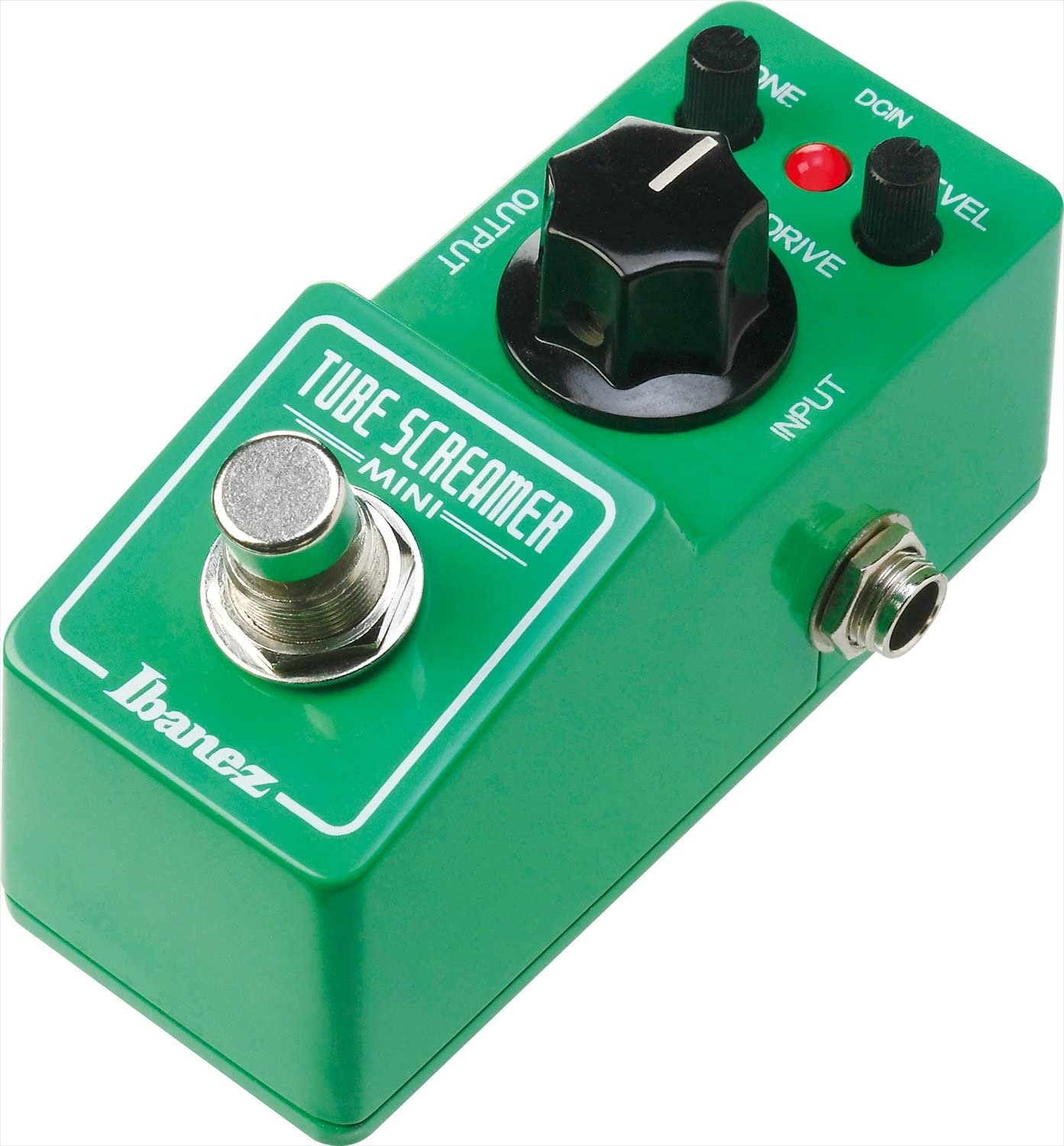
A closer look at the Ibanez Tube Screamer Mini reveals a compact yet potent overdrive pedal for guitars.
Though it may be small, don’t let its size deceive you.
Sporting a legendary midrange growl, this pedal charms guitarists from all walks of life with its expressive touch sensitivity.
It stays true to its heritage with a familiar green finish while giving users control over various tones with three uncomplicated knobs.
Being just under 6 inches long, 3 inches wide, and slightly over 4 inches high, it’s perfectly designed to fit on even the most cluttered pedalboard.
Its lightweight nature at 240 grams further enhances its convenience.
The Mini variation of the iconic Ibanez Tube Screamer carries forward the same overdrive style in a significantly condensed form.
Don’t forget about its commendable stomp responsiveness that guitarists would appreciate.
This small, green, overdrive magic box is ready to growl when you need it.
- My Review
Upon unboxing the Ibanez Tube Screamer Mini, my first impression was of its surprisingly compact size.
Pint-sized yet powerful, this overdrive pedal doesn’t sacrifice anything regarding quality and tone.
It has been carefully designed to conserve valuable pedalboard space without skimping on the Tube Screamer’s legendary sonic power.
One of my initial concerns was whether the pedal’s performance could measure up to the classic Tube Screamer models.
On plugging it in, I was met with that quintessential Tube Screamer midrange growl.
Delightfully expressive and sensitive to touch, it immediately became clear that this tiny powerhouse could punch above its weight class.
You can tweak your sound to your liking with the user-friendly controls, which consist of level, tone, and overdrive knobs.
The green paint job adds nostalgia, maintaining the Tube Screamer’s identity.
And there’s something gratifying about the pedal’s stomp responsiveness.
It feels reliable and robust underfoot, ready to roar into action at a moment’s notice.
Despite its many strong points, a few areas could improve.
The tone and volume of dials can be difficult to read without adequate lighting due to the lack of contrasting colors.
And I discovered it doesn’t come with its power adapter, which could be inconvenient for some.
Regarding delivering that sought-after Tube Screamer sounds in a space-saving design, Ibanez has done a remarkable job with the Tube Screamer Mini.
Here are the ratings I’ll give to the Ibanez Tube Screamer Mini Pedal:
Despite minor drawbacks, it is, without a doubt, a commendable addition to any guitarist’s rig, particularly if you’re short on pedalboard real estate.
Moreover, it showcases how a classic can be successfully reimagined for the modern era while staying true to its roots.
- Pros:
- Compact size
- Responsive stomp button
- Classic Tube Screamer tone
- Enhances sustain and adds compression
- Good for stuffed pedal boards
- Cons:
- Potential switch-pop issue
- Variable quality control
- Thin or distorted tone for some
- Hard-to-read knobs
- Noisy in some cases
My final verdict is that the Ibanez Tube Screamer Mini is a highly regarded overdrive pedal with a classic Tube Screamer tone.
Despite potential drawbacks such as switch-pop issues and variable quality control, the pedal offers a compact size, a responsive stomp button, and spot-on tones.
It enhances sustain, adds compression, and is a great addition to pedal boards.
The brand reputation of Ibanez adds to its appeal, and overall, it provides good value for guitarists seeking a versatile overdrive pedal.
Jim Dunlop Mini Wah Pedal
Legendary sounds, miniature size: Jim Dunlop Mini Wah.
Dunlop Manufacturing creates world-class gear for musicians, offering a variety of picks, pedals and accessories. Their products are used by legendary and current day superstars, and they strive to push new innovations and tweak classic sounds.
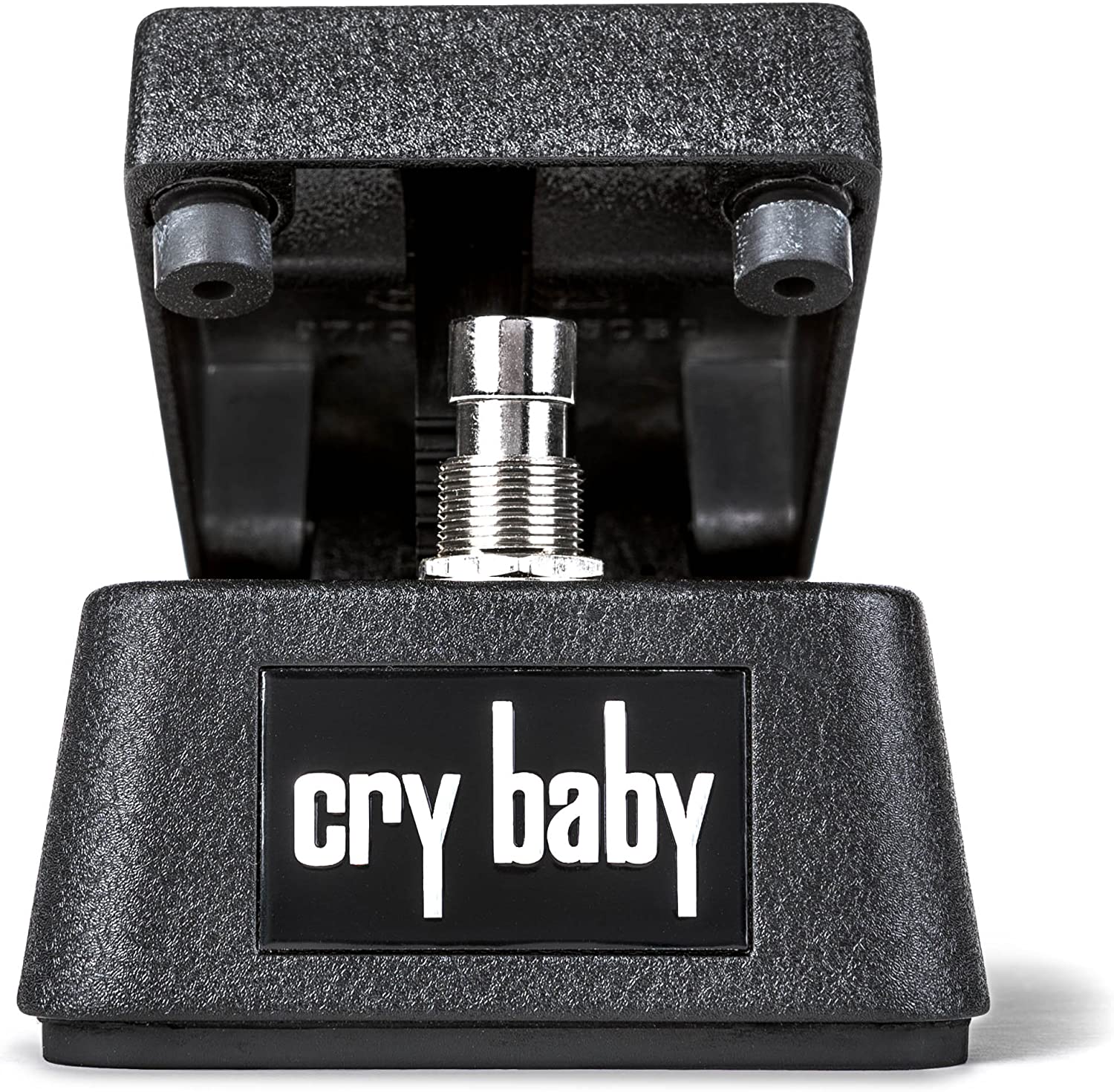
If you’re a musician looking for a compact, powerful tool, the Jim Dunlop Mini Wah could be your answer.
This miniature version of the classic Cry Baby pedal maintains the performance while taking up only half the space.
Featuring an array of voicings, you can adjust the internal settings to craft your desired sound.
It also boasts a comprehensive sweep range, giving you total control over your sound effects.
With its striking black exterior, the Mini Wah is as aesthetically pleasing as it is practical.
Weighing in at a mere 1.1 pounds, it’s easy to transport, while its dimensions of 5.2 x 3 x 2.6 inches allow it to fit snugly in most pedal boards.
The creators at Jim Dunlop have a long-standing reputation for developing premium-quality gear for musicians.
Their dedication to quality is evident in this Mini Wah, just as in every accessory they design and produce.
The model number, CBM95, is worth noting if you wish to research it further.
- My Review
Having tried the Jim Dunlop Mini Wah, I can confidently say it holds its own against its larger counterparts.
Compact and lightweight, it fits effortlessly into a crowded pedal board, making it a convenient choice for musicians with limited space.
In addition, the black, sleek aesthetic adds a cool edge that complements its practicality.
The CBM95 model is a force to be reckoned with regarding sound quality.
Offering an impressive array of voicings gives me control to shape my sound as I see fit.
Moreover, despite its miniature size, it doesn’t compromise on a wide, expressive sweep range – an essential aspect for any Wah pedal.
Adjusting the internal settings was initially challenging, but once I got the hang of it, it opened up a world of sonic possibilities.
And it’s amazing how its design keeps the integrity of the original Cry Baby tone intact while being half its size.
Still, I would be remiss not to mention that the small size could be challenging for those used to larger pedals.
It took me a while to adjust to the feel of it under my foot.
But once I got used to it, it was smooth sailing.
Despite this minor gripe, I can’t deny the clever engineering behind the Mini Wah.
It’s a testament to Jim Dunlop’s commitment to delivering top-notch music gear without compromising convenience or performance.
It’s a powerful accessory packed into a small, unassuming package.
Here are the ratings I’ll give to the Jim Dunlop Mini Wah Pedal:
Whether I’m playing at home, a gig, or a recording studio, this pedal is a reliable companion that adds that extra ‘oomph’ to my sound.
It’s a nifty piece of gear that deserves a spot on any musician’s pedal board.
- Pros:
- Small size
- Three adjustable voicings
- Full sweep range
- Matches output volume well
- Cons:
- Shorter sweep than full-sized wahs
- May require more ankle movement
- Possible durability issues
- Potential difficulty in activating on/off switch
My final verdict is that the Jim Dunlop Mini Wah offers a compact and versatile wah pedal option with three adjustable voicings and a full sweep range.
It provides a good tone and performance, and the Dunlop brand is well-regarded in the industry.
However, potential drawbacks include a shorter sweep than full-sized wahs and possible durability issues.
But, overall, its features, performance, and brand reputation, the Jim Dunlop Mini Wah offers good value for guitarists looking for a compact wah pedal.
MOOER E7 Synth Micro Pedal
Transform guitar into synthesizer with MOOER E7 Synth Pedal.
MOOER E7 is a Polyphonic Guitar Synth Pedal with 7 custom synth tones, each with an arpeggiator, high/low frequency cut, attack and speed functions for versatile sound shaping. It allows guitarists to create synthesizer sounds without the need for pickups or mods.
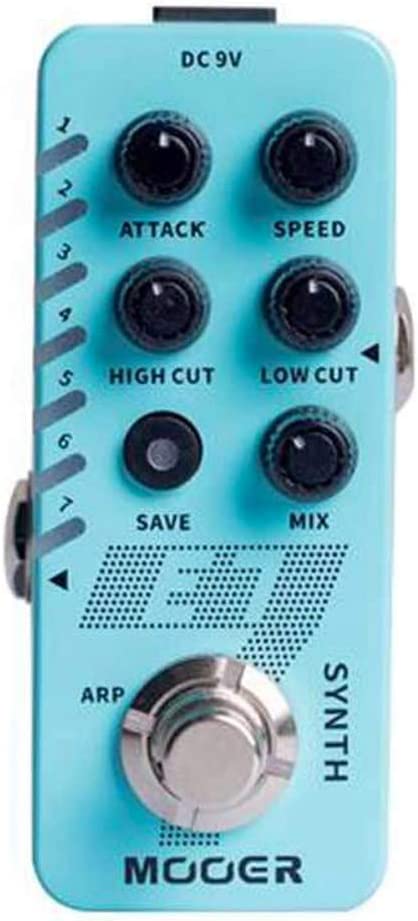
Discover the dynamic capabilities of the MOOER E7 SYNTH MICRO FX PEDAL.
This compact, unassuming device can morph your guitar into a vibrant electronic synthesizer without changing your instrument or pickups.
Among its features, it houses seven distinct synthesizer tones, each tailored by MOOER and accompanied by its unique arpeggiator.
Furnishing users with a broad scope for tonal exploration, each tone comes equipped with a high/low-frequency cut, speed function, and attack.
Storage is never a concern, as this petite pedal reserves seven slots for users to keep custom presets.
Additionally, as part of MOOER’s new Micro series, it boasts seven LED indicators on its casing, allowing for intuitive interaction.
Weighing in at a mere 28 grams, this pedal runs on 9 volts, and its dimensions are a practical 3.94 x 2.36 x 1.97 inches, perfectly sized for any pedalboard.
Plus, firmware upgrades are a breeze via USB for those who appreciate updating their gear.
- My Review
Taking the MOOER E7 SYNTH MICRO FX PEDAL for a spin revealed a powerful piece of kit, surprisingly dynamic for its compact size.
Packed within its tiny frame, I found seven diverse synthesizer tones that transformed my guitar into an electronic beast – a transformation requiring no alterations to my instrument or pickups.
It’s a revolution made simple.
Every tone provided a new palette of sound to explore, each equipped with individual arpeggiators, a feature typically only found in full-fledged synthesizers.
In addition, high and low-frequency cuts, adjustable attack, and speed functions allowed for meticulous shaping of the output.
What drew me in was the user interface; seven LED indicators on the casing clearly display the active tone, eliminating any guesswork.
Despite its complexity, navigating the MOOER E7 felt like a breeze, a testament to its well-considered design.
Storing my preferred settings was a cinch, with seven dedicated slots to save custom presets.
This feature is a godsend, eliminating the need to adjust settings each time I switch tones – a time-saver for both studio sessions and live performances.
A minor setback was the pedal’s lightweight.
Weighing only 28 grams, it sometimes moved around on the floor, but nothing a bit of two-sided tape couldn’t fix.
Again, however, the compact design, barely larger than a matchbox at 3.94 x 2.36 x 1.97 inches, is welcome in an often crowded pedalboard space.
Impressively, the MOOER E7 offers firmware upgrades via USB.
Seeing a company supporting their product is refreshing, a good sign for long-term usability.
To sum up, this pedal has been a delightful discovery.
Here are the ratings I’ll give to the MOOER E7 Synth Micro Pedal:
Of course, it’s got a learning curve, but it’s worth every minute spent mastering its functions.
The MOOER E7 SYNTH MICRO FX PEDAL isn’t just an effects unit; it’s a game changer.
- Pros:
- Compact and portable.
- No instrument modifications required.
- 7 different MOOER custom synthesizer tones.
- Individual arpeggiator for each tone.
- 7 user preset slots.
- Cons:
- Limited to 7 pre-defined synthesizer tones.
- May require additional adjustment for desired tones.
- Possible learning curve for using arpeggiators effectively.
My final verdict is that the MOOER E7 Synth Micro FX Pedal is a highly versatile and feature-rich product with excellent tone and performance.
The brand has a good reputation, and the pedal provides good value for its price.
While it may have a few limitations, such as the predefined synthesizer tones and a potential learning curve for the arpeggiators, it is a solid choice for guitarists looking to explore electronic synthesizer sounds without modifying their instruments.
Dunlop FFM3 Jimi Hendrix Fuzz Face Mini Distortion Pedal
Legendary Hendrix-style fuzz in a compact package.
The Fuzz Face Mini pedal line offers legendary Fuzz Face tones in smaller, pedalboard-friendly housings, plus status LED, AC power, and battery door. The FFM3 Jimi Hendrix Fuzz Face Mini features the same circuit as the JHF1 in a smaller housing for thick, smooth tones.
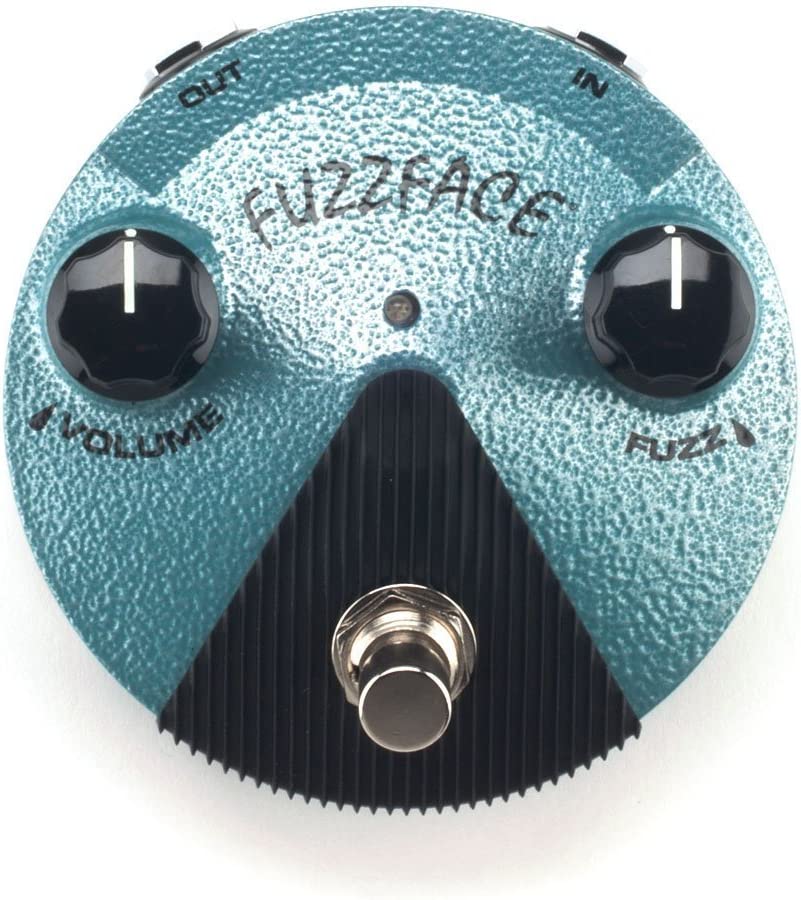
Crafted by the renowned JIM DUNLOP brand, the Dunlop FFM3 Jimi Hendrix Fuzz Face Mini Distortion pedal is a compact device that delivers robust and smooth tones reminiscent of the iconic Jimi Hendrix sound.
It’s a smaller, pedalboard-friendly model that maintains the integrity of its original counterpart, and it’s outfitted with several modern tweaks for your convenience.
These upgrades include a bright status LED for easy visibility, a built-in AC power jack, and a practical battery door.
In terms of its structure, this distortion pedal measures 10 x 8 x 8 inches, operating at a voltage and amperage of 9 and 9 milliamps, respectively.
It retains the true bypass switching found in original Fuzz Face models.
Its distinct, thick, and smooth tone comes from a circuit akin to the one found in the JHF1 model, all packed in a more compact housing.
So whether you’re performing on a grand stage or practicing in your bedroom, the FFM3 will serve your needs.
- My Review
Trying out the Dunlop FFM3 Jimi Hendrix Fuzz Face Mini Distortion, I was instantly struck by its compact, pedalboard-friendly design that doesn’t sacrifice functionality for size.
Its user-friendly features are remarkable, the bright status LED, for instance, offers at-a-glance visibility of the pedal’s status, while the AC power jack and handy battery door offer convenient powering options.
Of course, the real magic starts once you plug this pedal in.
The circuitry, modeled after the JHF1, delivers that iconic, thick Jimi Hendrix fuzz sound that ablaze the soul.
Regardless of where you’re playing, you can count on the FFM3 to give you that rich, smooth tone you’re after.
Despite its undeniable charm, one aspect that might take a little getting used to is the controls.
Adjusting the distortion intensity using the guitar volume requires a little finesse.
While it’s amazing to have that level of control right from the guitar, finding the right spot for distortion could take some time.
It’s all part of the journey, though, and with a little patience, you’ll find the reward is worth it.
Another thing to keep in mind is the noise factor.
The FFM3 can get a bit noisy when the fuzz knob is turned to its maximum, but that’s easily remedied by adjusting the fuzz to around the 3 o’clock position, and the rest can be controlled right from your guitar volume.
Here are the ratings I’ll give to the Dunlop FFM3 Jimi Hendrix Fuzz Face Mini Distortion Pedal:
A notable plus about the FFM3 is its packaging – the design exudes a cool, retro vibe that will undoubtedly make it stand out on any pedalboard.
The Dunlop FFM3, with its lush tones and user-friendly features, beautifully encapsulates the spirit of Jimi Hendrix’s sound, offering a fantastic journey for any music lover.
- Pros:
- Compact size and pedalboard-friendly.
- Delivers Jimi Hendrix’s iconic Fuzz Face tone.
- Bright status LED for easy visibility.
- Cons:
- May not be compatible with certain guitars.
- Using a wah pedal alongside it may cause issues.
My final verdict is that the Dunlop FFM3 Jimi Hendrix Fuzz Face Mini Distortion is a solid choice for guitarists seeking Jimi Hendrix’s iconic Fuzz Face tone in a compact and pedalboard-friendly design.
Its bright status LED, true bypass switching, and authentic Fuzz Face circuit offer a satisfying performance and deliver the desired fuzz characteristics.
While it may have compatibility issues with certain guitars and using it alongside a wah pedal may cause some complications, its versatility, features, tone, performance, brand reputation, and value make it a worthwhile investment for fans of classic fuzz tones.
Ibanez Mini Chorus Guitar Pedal
Legendary Ibanez mini-chorus for warm, ethereal tone.
Ibanez’s CSMINI is a mini-pedal version of their classic warm and ethereal chorus pedal, with a true bypass switch, 100% analog circuitry, Depth, Speed and Level knobs. Perfect for a crowded pedal board!
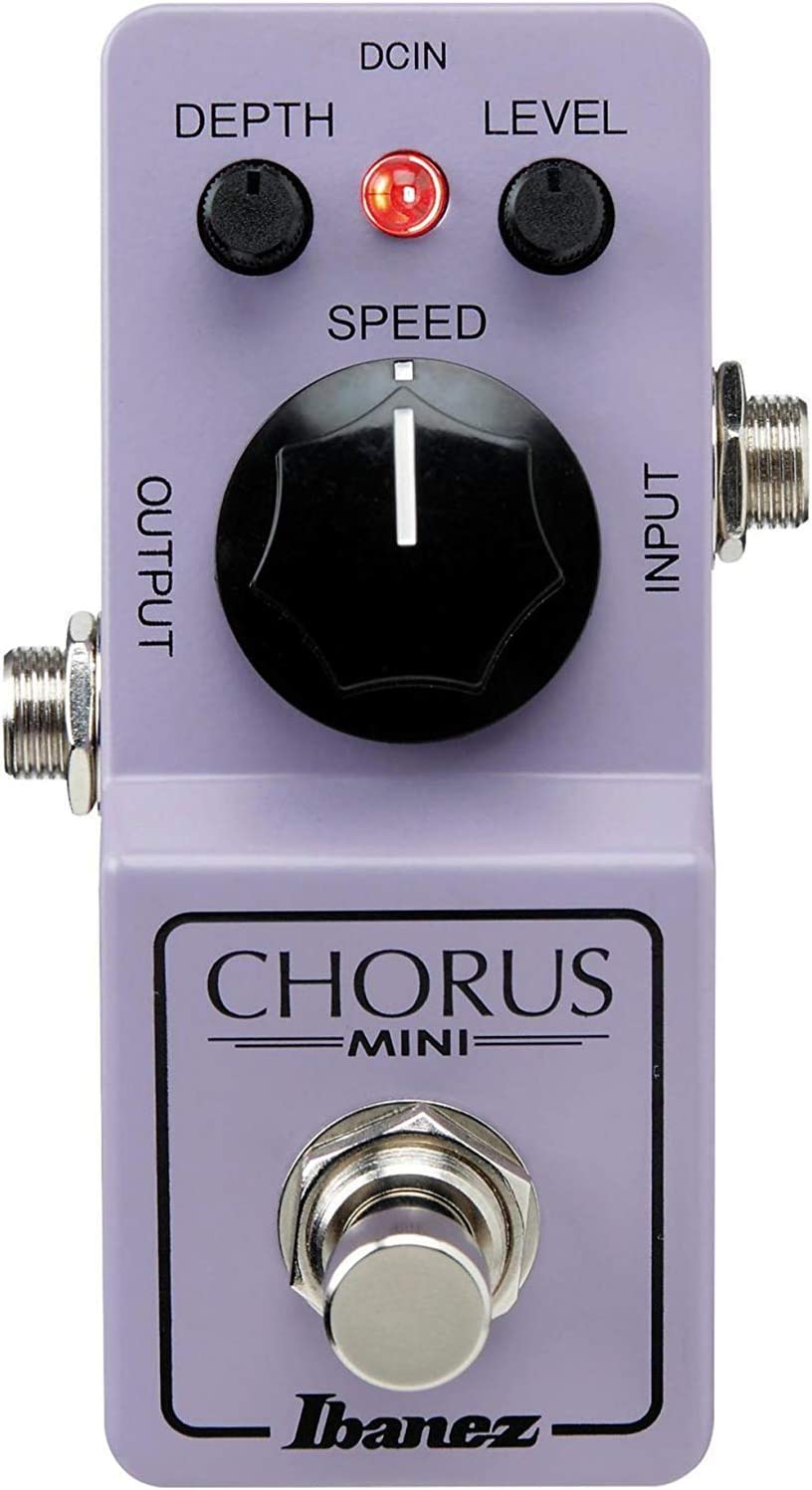
Crafted in Japan, the Ibanez Mini Chorus Guitar Pedal is a compact device designed for the modern guitarist seeking the best quality effects in a small package.
Despite its size, this little powerhouse packs some serious analog magic.
It has a trio of knobs—Speed, Depth, and Level—each allowing for nuanced adjustments to create your perfect chorus sound.
Significantly, the Speed knob is enlarged for ease of use while the Depth and Level knobs remain smaller for precision control.
Equipped with true bypass switching, it offers a pure, uncolored tone by directing your signal straight from the input to the output.
Compact and versatile, this purple pedal fits seamlessly on any pedal board.
With dimensions of 3.85 x 2.5 x 2.4 inches and operating at a voltage of 9 volts, this pedal embodies Ibanez’s commitment to creating high-quality, miniaturized versions of its most revered pedals.
- My Review
Stepping into the world of the Ibanez Mini Chorus Guitar Pedal, I was immediately struck by its compact, ergonomic design.
This petite purple unit, barely larger than a deck of cards, fit snugly onto my pedal board, leaving room for other gear.
I was even more impressed once I started tweaking the Speed, Depth, and Level knobs.
These three intuitive controls shaped the chorus effect to my liking, each adjustment adding a new dimension to the soundscape.
Surprisingly, the large Speed knob proved to be a game-changer.
Its enlarged size made on-the-fly adjustments a breeze, while the smaller Depth and Level knobs allowed for detailed tinkering.
As a result, I got everything from a gentle, subtle chorus to an all-out, swirling psychedelic vibe with a few deft turns.
One detail that did catch my attention was the true bypass switch.
Engaging it resulted in a crystal-clear tone, with none of the signal degradation that can sometimes plague effects pedals.
It’s a testament to Ibanez’s attention to detail and commitment to maintaining the integrity of the original guitar sound.
However, what truly set this pedal apart was its 100% analog circuitry.
There’s something magical about analog— it adds warmth and depth that digital effects often struggle to replicate.
For example, in using the Ibanez Mini Chorus, I found my sound enveloped in a rich, warm, and ethereal chorus effect that was truly captivating.
Having experienced this pedal firsthand, my only minor criticism would be the smaller Level knob, which I found slightly less convenient to adjust than the generously sized Speed knob.
However, this is a minor gripe and hardly detracts from what is, overall, an exceptional pedal.
Here are the ratings I’ll give to the Ibanez Mini Chorus Guitar Pedal:
This Ibanez Mini Chorus Pedal has a spot reserved on my pedalboard.
It’s a mini titan that delivers big on quality and versatility.
- Pros:
- Compact size
- 100% analog circuitry
- Versatile controls
- True bypass switching
- Cons:
- Limited color options (purple)
My final verdict is that the Ibanez Mini Chorus Guitar Pedal is an excellent choice for guitarists looking for a compact and versatile chorus pedal.
Its 100% analog circuitry, versatile controls, and true bypass switching offer a range of warm and ethereal chorus effects.
The pedal’s performance, brand reputation, and value for money make it a reliable option for musicians.
However, the limited color options (purple) may not appeal to everyone.
Considering its features and performance, the Ibanez Mini Chorus Guitar Pedal receives a positive recommendation.
Xotic EP Booster Mini EQ Effect Pedal
Classic Echoplex-inspired boost with customizable sparkle and drive.
The Xotic EP Booster is a FET preamp pedal offering up to 20db of gain, Bass Boost and Bright switches for tone customization, and low impedance output for classic boost tone. Ideal for darker sounding instruments, the EP Booster provides an extra edge and shimmer to your sound.
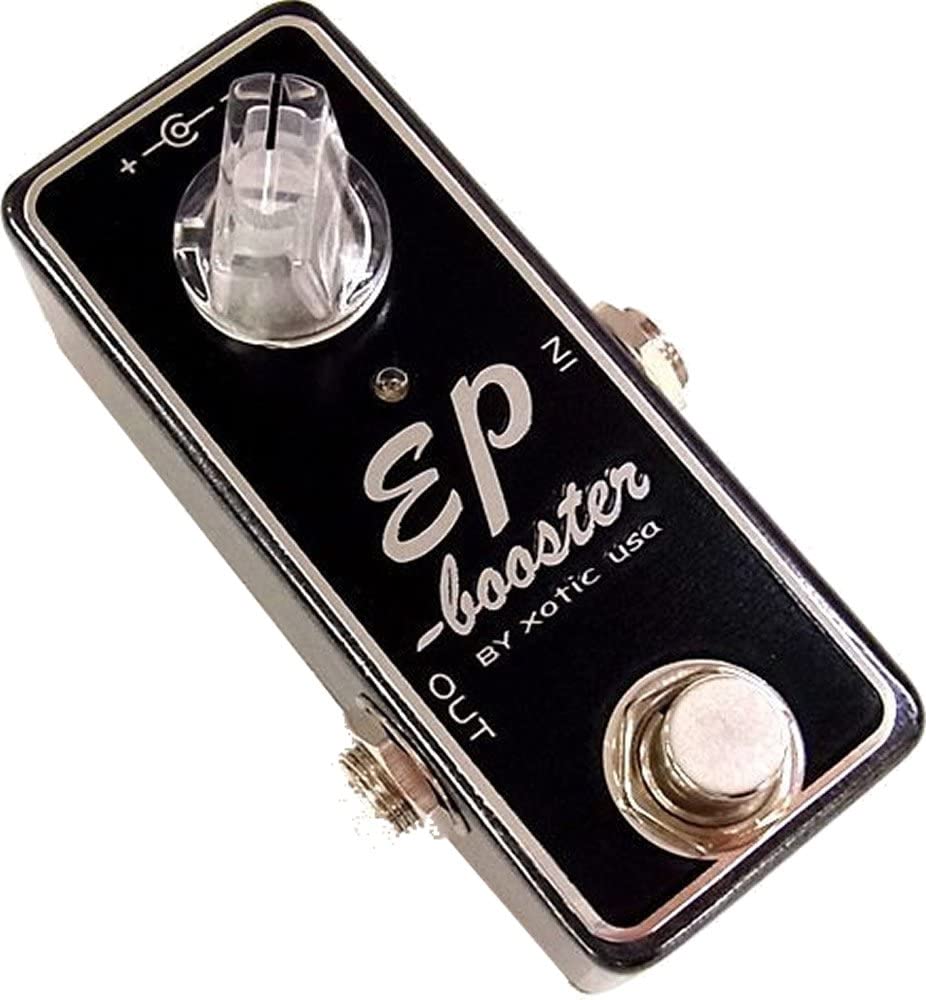
Meet the Xotic EP Booster Mini EQ Effect Pedal – a powerhouse designed to amp up your guitar sound.
As a small yet mighty pedal, it carries the pedigree of the classic Echoplex preamp, renowned for its high-end sparkle and defining tone.
Sporting a Discrete FET Preamp, the Xotic EP Booster can dial up to +20db of gain, offering a full power range.
At the core of this unit are two internal DIP switches for tone customization, one for adding bass to enhance low-end frequencies, perfect for single coils, and another for brightness, ideal for darker-sounding instruments.
Operable between 9 and 18 volts, it offers flexibility according to your power needs.
On the outside, its classic design cloaked in a sleek black shell measuring 5.6 by 3.2 by 2.8 inches and weighing a mere 0.8 pounds makes it a compact companion that won’t crowd your pedalboard.
Instead, this is a musical tool built for musicians seeking that elusive classic tone.
- My Review
Stepping on the Xotic EP Booster Mini EQ Effect Pedal for the first time was like unlocking a new dimension in my guitar tone.
It brought much-needed warmth and depth, adding a sparkle to my sound that I never knew I was missing.
The impact was immediate yet subtle, enhancing my tone without overshadowing my guitar’s natural voice.
Packing so much power in such a small package, the EP Booster is surprisingly potent.
A slight twist of the single knob provided me up to +20db of uncolored gain, lifting my sound to new levels of clarity and richness.
I didn’t just hear the difference but felt it in every note I played.
It’s the kind of experience that reshapes how you think about tone enhancement.
Moreover, the internal DIP switches added an extra layer of control.
As a result, I could tailor the EQ to my liking, adding a nice, bassy punch when using my single-coil pickup and introducing a bit of brightness to balance out my darker-sounding instruments.
Such an attentive design makes this pedal an invaluable asset to any guitar rig.
I ran the EP Booster at 9 and 18 volts, performing impeccably under both conditions.
While I enjoyed the added headroom at 18 volts, the pedal didn’t lose any of its magic at 9 volts, a testament to its robust build and quality design.
One minor gripe I had was the absence of an LED indicator to let me know when the brightness or bass boost was activated.
Here are the ratings I’ll give to the Xotic EP Booster Mini EQ Effect Pedal:
Nevertheless, this is a minor shortcoming in an otherwise flawless piece of gear.
If you’re hunting for a robust, versatile, tone-enhancing boost pedal, the Xotic EP Booster should be on your radar.
- Pros:
- Warm and defined boost tone
- Customizable with internal switches
- Enhances clean tones and single-coil pickups
- Compact and sturdy design
- Positive user reviews
- Cons:
- Possible coloration of the sound
- Noise issues reported by some users
- May not meet expectations for all setups
My final verdict is that the Xotic EP Booster Mini EQ Effect Pedal is a versatile and feature-packed pedal that delivers warm and defined boost tones.
Its customizable internal switches and positive user reviews offer a range of options to enhance your clean tones and single-coil pickups.
While some concerns were raised about potential sound coloration and noise issues, overall, this pedal performs well and has a reputable brand’s reputation.
Furthermore, considering its compact and sturdy design, the Xotic EP Booster Mini EQ Effect Pedal offers good value for those seeking to add sparkle and definition to their tone.
Wampler Mini Faux Spring Reverb Pedal
Authentic, mini spring reverb with adjustable tone and level.
The Wampler Mini Faux Spring Reverb effects pedal offers a powerful, authentic spring reverb sound, with adjustable Depth, Volume, and Tone knobs for precise control. This pedal is perfect for creating a range of tones, from subtle and gentle to brash and wet. Designed to fit most amps and rigs, it is a great choice for any musician looking for a versatile reverb pedal.
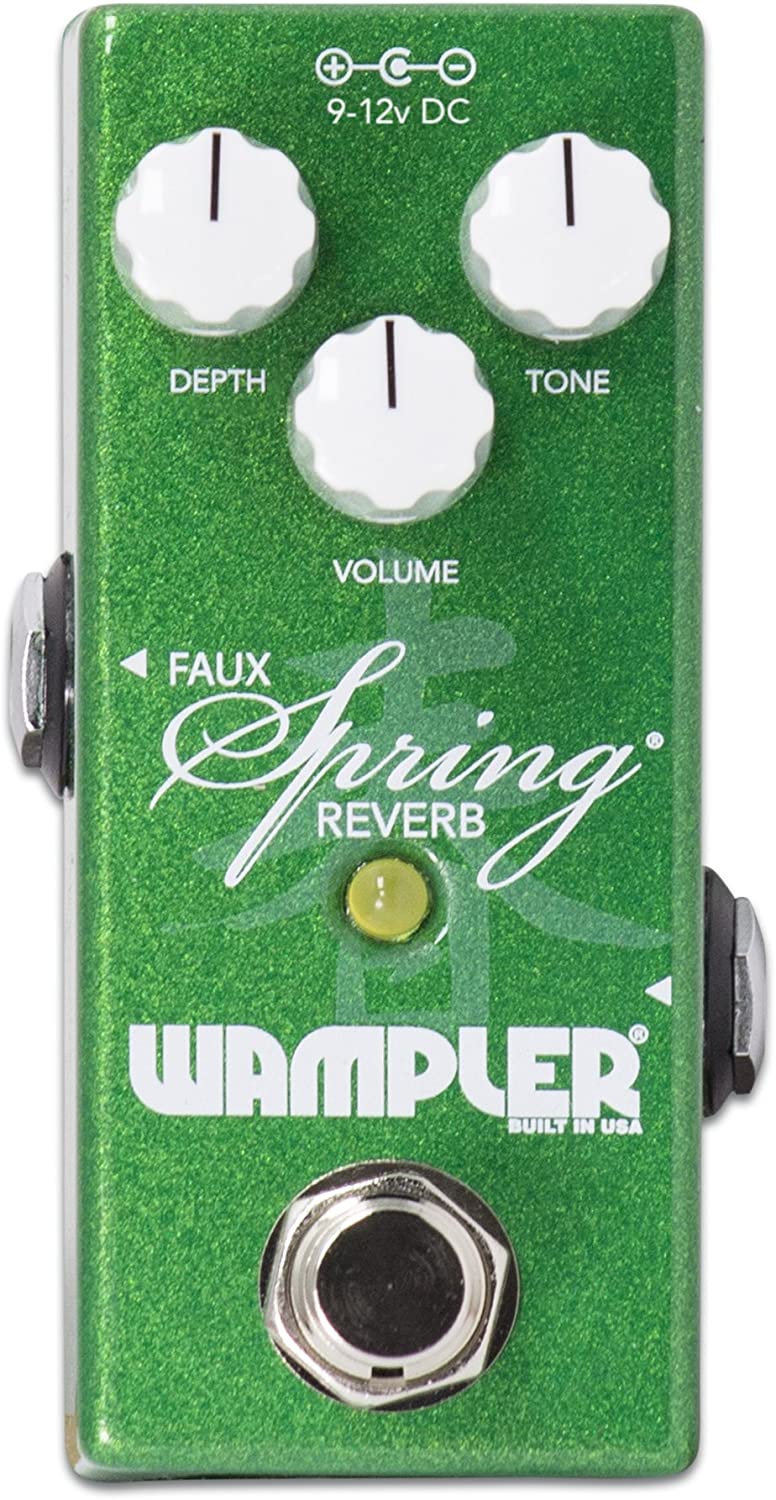
Meet the Wampler Mini Faux Spring Reverb Pedal, a compact yet potent tool for guitarists.
This tiny marvel captures the essence of the classic Faux Spring Reverb, packing it all into a miniaturized shell that can snugly fit onto any pedalboard or in an amplifier’s effects loop.
It is impressive that despite its downsized form, it comes with enhanced features – more pronounced decay, amplified drippiness, and that loved bouncy spring tone.
This compact gadget lets you quickly pull up your desired tone thanks to its user-friendly control layout.
Regarding its sound capabilities, it offers an extended decay time that captures the real essence of the spring reverb tone, resulting in an authentic, boing-laden sound.
To top it all, its miniature size is perfect for on-the-go use, easily storable in the back of your open-back combo.
One of its major highlights is its specifications; this is an improved version of a beloved classic resurrected in response to a steady stream of player requests.
The designers have worked hard to preserve what guitarists love about the original, enhancing its sound with longer decay, heightened drippiness, and an amplified bouncy spring tone.
All these features are packed into a conveniently sized pedal, making it a perfect fit for your chain.
- My Review
First off, I have to say that the Wampler Mini Faux Spring Reverb Effects Pedal is a game changer for those looking to achieve that authentic spring reverb sound in a compact and convenient package.
As someone who has tried this pedal, I can confidently say it offers exceptional tonal quality and versatility.
Thanks to the user-friendly control layout, I was amazed at how easy it was to find my perfect reverb tone.
The Depth, Volume, and Tone knobs gave me an impressive range of options and enabled me to dial in my desired effect precisely.
The pedal’s size is also a real bonus, making it ideal for musicians with cramped pedalboards or those who frequently need to transport their gear.
During my time spent playing with the Wampler Mini Faux Spring Reverb, I couldn’t help but notice its ability to deliver more decay, drippiness, and that unmistakable bouncy spring tone, especially in comparison to other reverb pedals I’ve tried in the past.
In addition, its extended decay time is remarkable, allowing for an authentic tone dripping with character.
One thing that blew me away was how the Mini Faux Spring Reverb offered such a rich and full sound despite its compact size.
The pedal’s precise recreation of a true spring reverb is genuinely impressive, and the amount of research and development that went into perfecting this product is evident in its performance.
However, it’s worth noting that the reverb’s sound can increase dramatically when using this pedal with an overdriven or distorted amp.
Therefore, it’s essential to carefully adjust the Level control to maintain your desired reverb level when playing at higher volumes.
Here are the ratings I’ll give to the Wampler Mini Faux Spring Reverb Pedal:
To wrap it up, the Wampler Mini Faux Spring Reverb Guitar Effects Pedal is an outstanding choice for anyone seeking to add an authentic, high-quality spring reverb effect to their rig.
Its ease of use, compact size, and exceptional tonal capabilities make it my go-to pedal for those classic spring reverb sounds.
- Pros:
- Authentic spring reverb sound
- Compact size fits well on pedalboards
- Extended decay time for immersive tones
- Cons:
- No specific cons reported
My final verdict is that the Wampler Mini Faux Spring Reverb Guitar Effects Pedal appears to be a solid choice for guitar players seeking authentic spring reverb tones in a compact package.
With its extended decay time, versatile control layout, and the reputation of the Wampler brand, it offers promising features.
While individual preferences may vary, the positive aspects, such as tone, performance, and brand reputation, make it a compelling option.
Considering the lack of reported cons and the value it provides, the Wampler Mini Faux Spring Reverb Pedal seems to be a worthwhile investment for guitarists seeking quality reverb effects.
Tone City Tape Machine Delay A Mighty Mini Pedal
Warm and musical delay, noiseless and portable with true bypass.
Tone City Tape Machine Delay provides warm and musical delay tones, with noiseless operation and true bypass switching. It features 3 simple controls of Time, Level and Repeat, and is built into a micro pedal format for placement versatility.
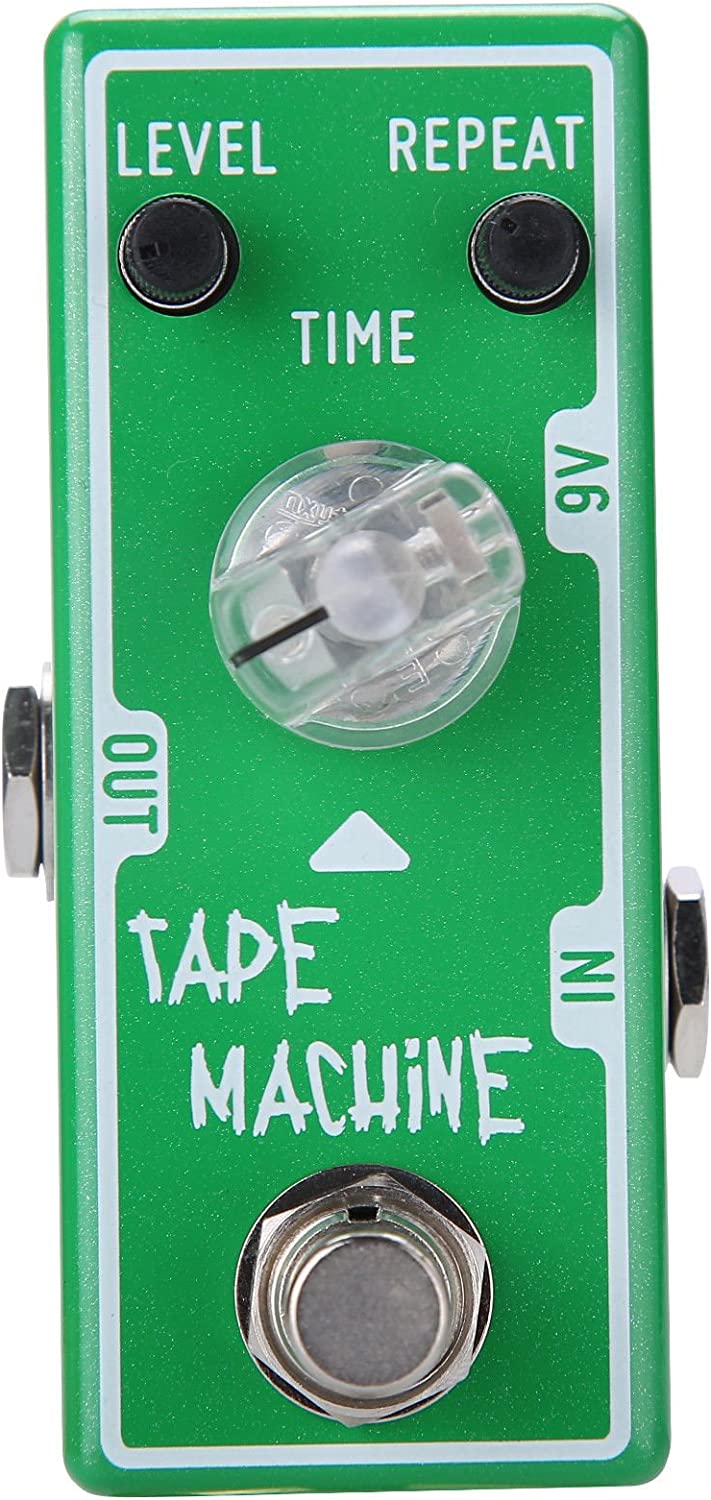
The Tone City Tape Machine Delay is a small yet powerful delay pedal designed to enhance your guitar’s sound.
It offers a wide range of delay times, from 25-600ms, to help create the perfect atmosphere for your playing.
Its compact, mini size makes it easy to fit on any pedalboard and transport to gigs.
Besides its size, this mighty mini pedal features a true bypass to maintain the purity of your sound when not in use.
A standout aspect of this delay pedal is its warm and musical nature, making it an excellent addition to solos and rhythm parts alike.
In addition, it has a user-friendly setup featuring three straightforward controls: Time, Level, and Repeat.
This makes it simple to adjust the sound and get the desired effect.
Tone City’s T-4 Tape Machine Delay is built to last with high-quality components and a solid metal exterior.
In addition, it requires a 9V power adapter, making it easy to include in your pedalboard setup.
- My Review
I have to say, the Tone City Tape Machine Delay impressed me with its ability to produce warm and musical soundscapes with ease.
This small yet powerful pedal can instantly elevate solos and rhythm parts, adding a unique touch to any performance.
Its simple design, including only three controls for Time, Level, and Repeat, has quickly become one of my go-to pedals due to its straightforward operation.
In terms of versatility, the Tone City Tape Machine Delay delivers.
It offers various delay times, from short slap-backs to longer, lingering delays, suitable for various musical genres.
Although I wish it had an even longer delay time option, the 25-600ms range is still quite impressive for such a compact pedal.
The true bypass feature is a lifesaver on my pedalboard, ensuring the purity of my tone remains intact when the pedal is not in use.
Even when I needed high volumes and low guitar settings, the pedal gave me a good sound without any significant noise – though I did notice a slight hiss, not enough to be bothersome in most cases.
The mini size also makes it an attractive choice for musicians with limited pedalboard space, and the solid metal exterior signals that this is a pedal built to withstand the test of time.
Here are the ratings I’ll give to the Tone City Tape Machine Delay A Mighty Mini Pedal:
One area where I found room for improvement is the pedal’s background noise in certain situations.
Depending on their gear and playing style, some players might experience more noticeable hiss while using this pedal.
- Pros:
- Warm, musical delay effects.
- Compact and portable size.
- Simple, user-friendly setup.
- Cons:
- Minor background noise issues.
- Delay time could be longer.
- Requires external 9V power supply.
My final verdict is that the Tone City Tape Machine Delay is a worthy addition to any musician’s pedalboard.
Its warm, musical delay effects, compact size, and user-friendly setup offer exceptional value for the price.
Despite minor issues with background noise, its performance is consistently impressive, making it a great choice for those seeking versatility and quality in a delay pedal.
MXR Dyna Comp Mini Compressor Pedal
Classic tone, modern convenience in compact size.
This mini compressor pedal offers classic and transparent sound in a small housing. Its rare CA3080 IC yields quiet operation and an attack switch toggles between fast and slow attack times.
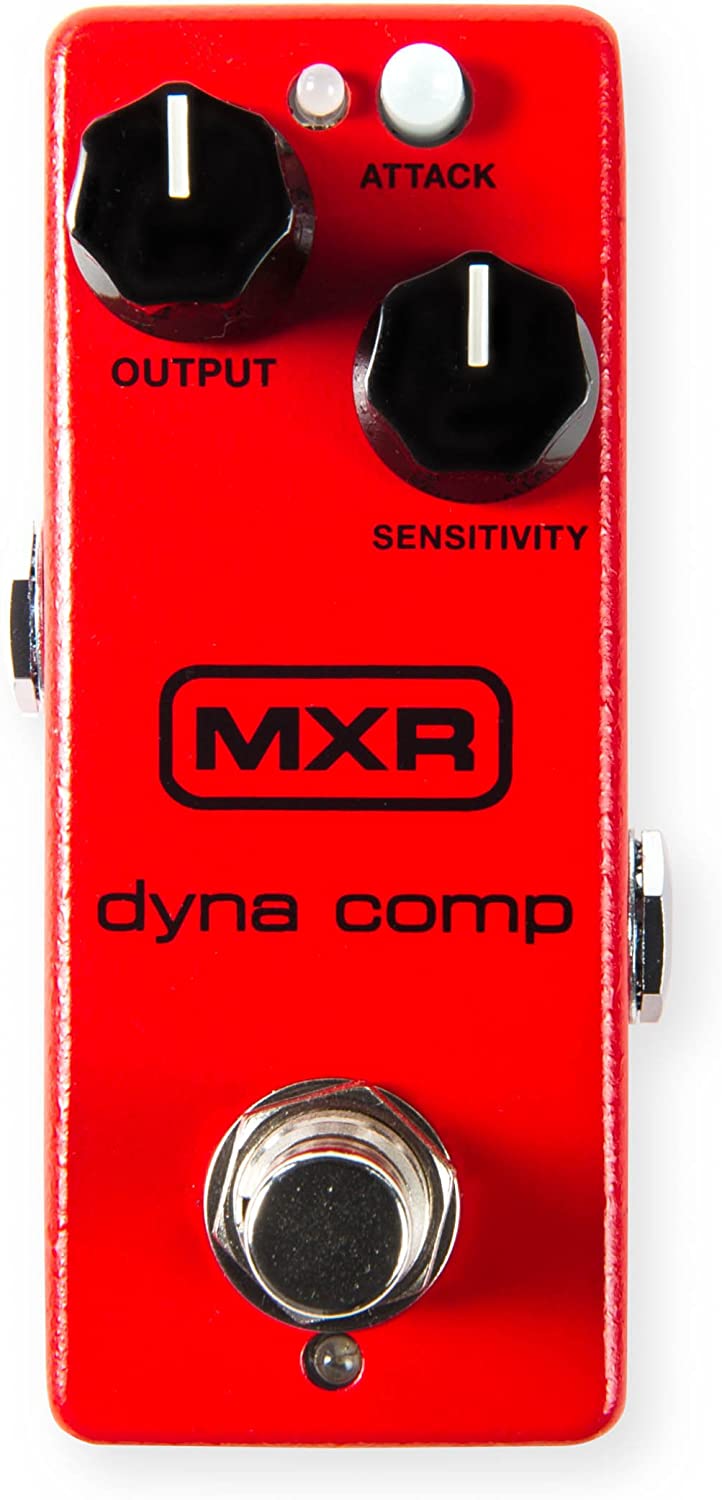
The MXR Dyna Comp Mini Compressor is a compact, space-saving guitar effects pedal that offers the classic MXR compression sound.
Its reduced size doesn’t compromise quality, as it features the rare CA3080 “metal can” integrated circuit (IC).
This IC provides quieter operation, greater transparency, and an increased dynamic range.
This mini compressor pedal is manufactured by the reputable brand Jim Dunlop and comes in a striking red color.
The item dimensions are 3.56 x 1.62 x 2.19 inches, and it weighs just 0.75 pounds, making it easily portable for musicians on the go.
One of the standout aspects of this guitar effects pedal is the addition of a new attack switch.
This allows users to toggle between slow and fast attack times, providing more versatility and control over their sound.
The MXR Dyna Comp Mini Compressor’s model number is M291, and its style categorization is both ‘compressor’ and ‘mini,’ which confirms its status as a reliable, compact, and efficient guitar effects pedal option.
- My Review
After trying the MXR Dyna Comp Mini Compressor guitar effects pedal, I can confidently say it has much going for it.
Its compact size impressed me, measuring just 3.56 x 1.62 x 2.19 inches and weighing 0.75 pounds.
This makes it extremely portable and easy to add to any pedalboard setup without taking up too much space.
The sound quality produced by this mini compressor is truly remarkable.
I found the CA3080 “metal can” integrated circuit to deliver on its promise of quieter operation and increased dynamic range.
As a result, the pedal provided exceptional transparency and allowed the true character of my guitar’s tone to shine through.
Moreover, I appreciated the versatility of the attack switch, which allowed me to toggle between slow and fast attack times.
With the press of a button, I could fine-tune the pedal to suit my playing style, whether I wanted a smoother, more sustained sound or a sharper, snappier tone.
While I was generally pleased with the performance of the Dyna Comp Mini, I did have a few minor grievances.
Firstly, I felt that the color, although striking, might not suit everyone’s taste or match their setup.
Additionally, some players may prefer even more tweaks and adjustments available to help shape the compressor to their liking.
Here are the ratings I’ll give to the MXR Dyna Comp Mini Compressor Pedal:
However, considering its compact size and stellar performance at an affordable price, I genuinely believe that this guitar effects pedal is a fantastic option for guitarists looking to incorporate classic MXR compression into their sound.
The Dyna Comp Mini proves that great things can come in small packages and reinforces Jim Dunlop’s reputation for producing top-notch guitar effects pedals.
- Pros:
- Compact and portable size.
- High-quality CA3080 IC.
- Attack switch for versatility.
- Cons:
- Red color not for everyone.
- Limited tweak options.
- No additional adjustments.
My final verdict is that the MXR Dyna Comp Mini Compressor is a reliable, high-quality guitar effects pedal that offers excellent performance, tone, and versatility.
The compact size and attack switch are standout features, making it a great addition to any guitarist’s setup.
While it may have a few drawbacks, such as limited tweak options and a polarizing color, its overall value and performance from a reputable brand like Jim Dunlop make it a worthwhile investment for musicians seeking a classic compression sound.
Nobels ODR-Mini Overdrive Pedal
Premium overdrive with true bypass, versatile tones, and adjustable bass-cut.
The Nobels ODR-Mini Overdrive Pedal offers a wide range of warm, creamy overdrive tones, from clean amp-like sounds to full-on distorted stacks. True bypass switching and the SPECTRUM pot with mid-click give you full control over your sound. The pedal is powered by 9-18V DC and is guaranteed to be a big part of your sound with a small footprint on your pedalboard.
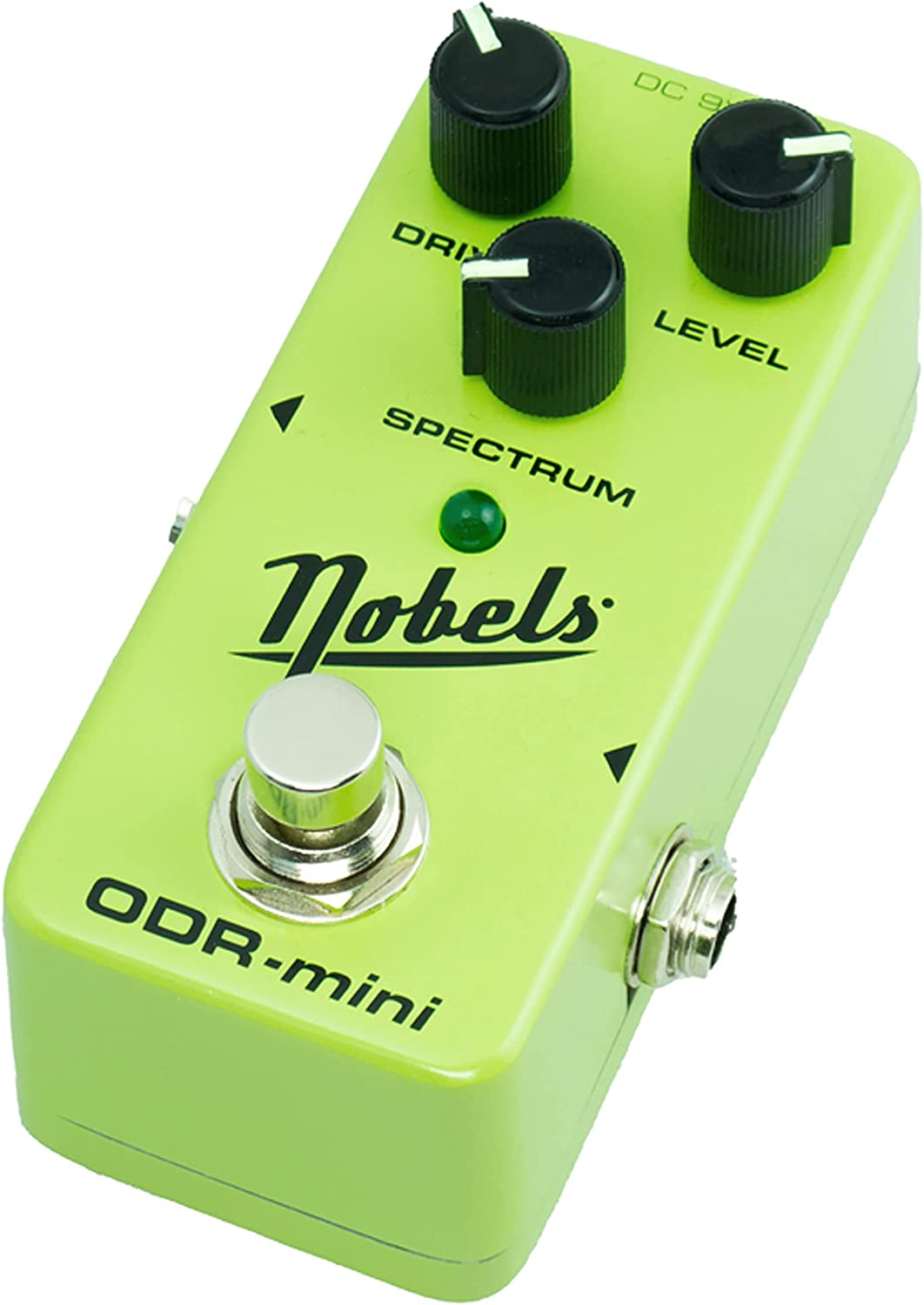
The Nobels ODR-Mini Overdrive Pedal in a vibrant green color is a compact version of the highly regarded ODR-1, offering the same incredible tones.
This analog, true bypass pedal is designed with mono input and output, making it perfect for guitarists seeking a creamy, natural overdrive effect.
In addition, it provides a wide range of sound options, from clean amp tones to heavy gain stacks, perfect for rock, blues, and hard rock genres.
Featuring Drive, Tone, and Level controls, the ODR-Mini allows you to craft your ideal overdrive easily.
Its unique SPECTRUM pot with a mid-click enables precise tonal adjustments, while the fluorescent pointers on the Glow-in-the-Dark knobs ensure easy visibility on stage.
This pedal is compatible with a 9-18 Volt DC electric stabilized power supply and requires a minimum of 100 mA with a 2.1mm plug, center negative (not included).
The Nobels ODR-Mini is a versatile and powerful pedal designed to significantly impact your sound while occupying only a small portion of your pedal board.
- My Review
After extensively testing the Nobels ODR-Mini Overdrive Pedal, I must say that I was thoroughly impressed with its performance.
This compact pedal delivers everything you could want in an overdrive – from subtly accentuating your guitar’s natural tones to pushing it into the heavy, gain-laden territory.
One of the first things I noticed about the ODR-Mini was its intuitive design and user-friendly interface.
With just three knobs to control Drive, Tone, and Level, dialing the perfect overdrive settings for any situation is easy.
I particularly appreciate the SPECTRUM pot, which offers a smooth mid-click for precise tonal adjustments.
In addition, the Glow-in-the-Dark knob pointers were a nice touch, making seeing your settings on a dark stage simple.
Sonically, the ODR-Mini packs a punch, delivering warm mid-gain tones for rock and blues and intense hard rock sounds.
I was amazed at how this small unit replicated the legendary tones of its larger ODR-1 sibling.
It also works harmoniously with your instrument’s volume control, allowing on-the-fly changes to your tone during performances.
The true bypass function is another great feature, ensuring your signal remains uncolored when the pedal is disengaged.
Furthermore, the option to power the ODR-Mini with either 9 or 18 volts adds an element of flexibility in terms of headroom and overall tone.
Although the pedal’s housing is compact, its construction is robust, and it seems well-suited to withstand the rigors of gigging.
The only minor drawback I could find was the lack of a power supply included in the package, which is common with many pedals.
Here are the ratings I’ll give to the Nobels ODR-Mini Overdrive Pedal:
The Nobels ODR-Mini Overdrive Pedal is a versatile and powerful piece of gear that I sincerely believe would be a fantastic addition to any guitarist’s pedalboard.
It offers high-quality, natural-sounding overdrive in a compact and user-friendly format, perfect for musicians on the go.
- Pros:
- Compact and user-friendly design.
- Versatile, natural-sounding overdrive.
- Compatible with 9-18 Volt power supplies.
- Cons:
- Power supply not included.
- Limited controls compared to larger pedals.
My final verdict is that the Nobels ODR-Mini Overdrive Pedal is an excellent choice for guitarists looking for a compact, versatile, and high-quality overdrive pedal.
Its user-friendly design, wide range of tones, and solid performance offer great value and is worth considering for a spot on your pedalboard.
TC Electronic Electric Guitar Pedal
Iconic, ultra-compact, TonePrint-ready reverb pedal with MASH footswitch.
HALL OF FAME 2 MINI REVERB is an ultra-compact, tone-packed reverb pedal featuring MASH Footswitch and Shimmer Reverb Algorithm. It offers a vast range of reverb sounds, from classic to modern, with ground-breaking MASH Footswitch, True and Buffered Bypass, and an Analog-Dry-Through.
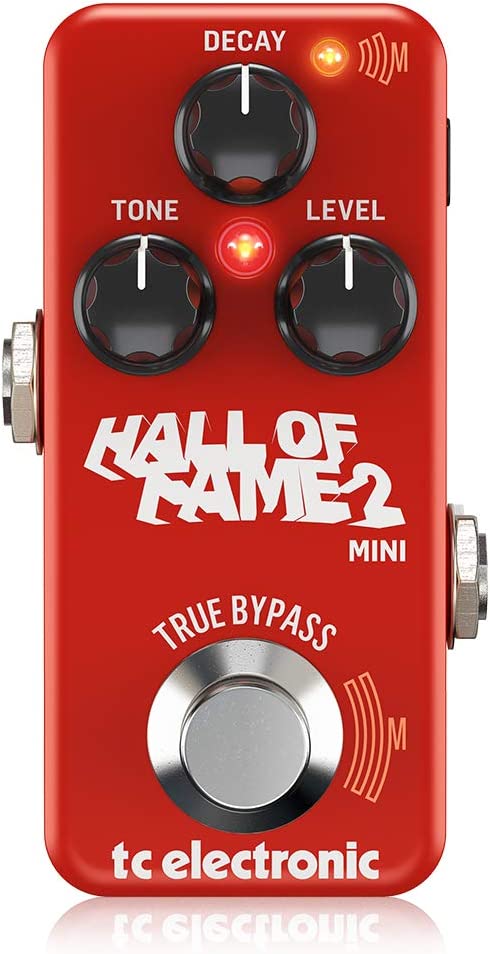
The TC Electronic Electric Guitar Single Effect (Hall of Fame 2 Mini Reverb) is a compact, innovative reverb pedal perfect for guitarists seeking incredible sound quality and versatility in a small package.
This tiny, ultra-compact pedal has a groundbreaking pressure-sensitive MASH footswitch, offering precise control over the effect’s parameters in real time.
The pedal boasts next-generation reverb algorithms, including the captivating new Shimmer reverb, creating an otherworldly sound experience.
With dedicated knobs for decay, tone, and mix, users can seamlessly fine-tune their reverb to their liking.
The pedal is also compatible with the free TonePrint App, allowing users to beam all Hall of Fame 2 reverbs into their pedal.
Designed in a stylish red and black color scheme, the Hall of Fame 2 Mini Reverb has dimensions of 3.95 x 2.5 x 2.4 inches and weighs just 0.44 pounds.
This iconic ultra-compact reverb pedal has been crafted to deliver amazing, natural-sounding reverberation in a space-saving design, making it an essential addition to any guitarist’s pedalboard.
- My Review
I recently enjoyed trying out the TC Electronic Electric Guitar Single Effect (Hall of Fame 2 Mini Reverb).
This small pedal was a tremendous addition to my guitar setup.
Its compact size makes it an ideal choice for those looking to save space on pedalboards without sacrificing quality.
One of the standout features of this reverb pedal is the innovative MASH footswitch, which offers total control over the effects simply by varying the pressure applied to the switch.
This unique feature allowed me to experiment and discover new sonic landscapes in my playing, taking my creativity to new heights.
The Hall of Fame 2 Mini Reverb also boasts next-generation reverb algorithms, including the mesmerizing Shimmer reverb, which added a captivating dimension to my guitar sound.
In addition, I appreciated the dedicated knobs for decay, tone, and mix, allowing me to fine-tune my desired reverb effect with ease.
While the pedal provides an excellent selection of reverbs, the compatibility with the free TonePrint App elevates the user experience even further.
I can access even more reverb options through the app and customize them to my preference.
In terms of build quality, the stylish red and black design and its compact and durable construction exude professionalism and reliability.
Furthermore, this pedal was designed with both performance and portability in mind.
However, I have one criticism regarding the Hall of Fame 2 Mini Reverb: the TonePrint app’s functionality on PCs. I found connecting the pedal to my computer challenging and experienced some lag and limitations within the app.
Despite this, the pedal remains a valuable asset to any guitarist’s arsenal.
Here are the ratings I’ll give to the TC Electronic Electric Guitar Pedal:
In my experience, the TC Electronic Hall of Fame 2 Mini Reverb is an exceptional reverb pedal that offers impressive sound quality, versatility, and innovation in a compact design.
I highly recommend this pedal to any guitarist seeking new creative ways to enhance their sound.
- Pros:
- Compact size and design.
- Innovative MASH footswitch.
- Wide range of reverb options.
- Cons:
- TonePrint app connectivity issues.
- Some limitations within the app.
- No built-in shimmer setting.
My final verdict is that the TC Electronic Hall of Fame 2 Mini Reverb is a versatile, compact, and innovative reverb pedal that delivers exceptional sound quality in a user-friendly design.
While the TonePrint app may have some connectivity issues and limitations, the overall performance of the pedal makes it a valuable addition to any guitarist’s setup.
Wampler Plexi Drive Mini Overdrive Pedal
Authentic Marshall crunch and tone in a mini pedal.
The Wampler Plexi-Drive Mini Overdrive Pedal offers a unique gain structure and Mid Boost circuit switch for classic Marshall-style crunch, from vintage ’68 to modern metal tones. It also features Bass Boost switch to emulate the tonal difference between 4×12 and 2×12 speaker cabs.
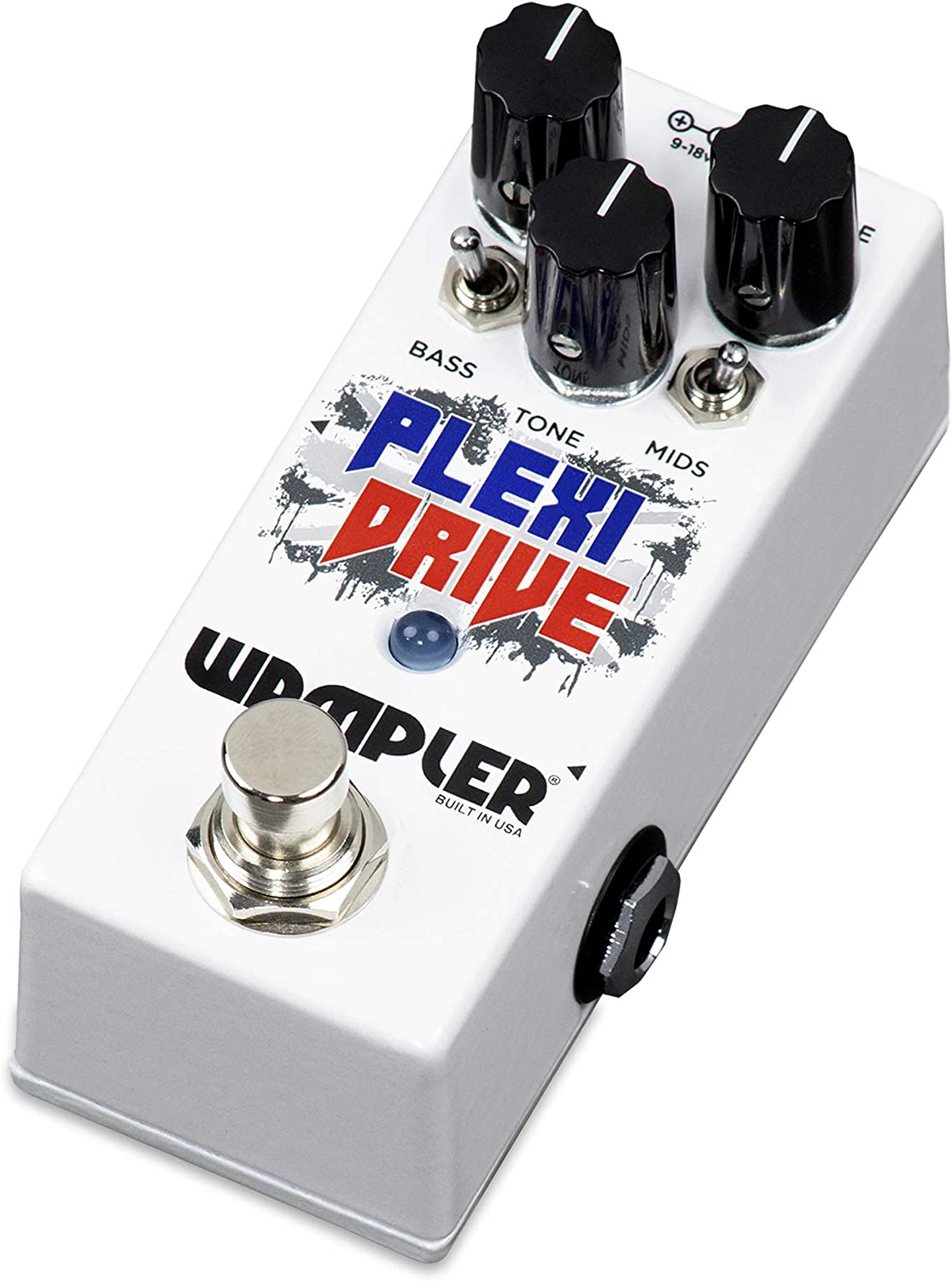
The cream color Wampler Plexi Drive Mini Overdrive Pedal is a compact and versatile guitar effect pedal designed and built in the United States, using high-quality components to ensure excellent sound and response.
It features a true bypass and can be powered by a 9v-18v power jack, although it does not have an internal battery connector.
This mini overdrive pedal comes with five controls, including Level, Gain, Color, Bass, and a Compression Clipping Switch, allowing you to choose between a more compressed or open sound.
With a legacy rooted in iconic rock tones from legendary bands like Jimi Hendrix, Led Zeppelin, and AC/DC, the Wampler Plexi Drive Mini aims to capture the essence of a vintage Marshall amplifier in a small, easy-to-use package.
The pedal offers an impressive range of tonal options, from classic ’68 Plexi sounds to massive, cranked JTM-45 rock tones.
The pedal also features a unique Mid Boost circuit switch for additional tonal possibilities and a Bass Boost switch that simulates the difference between 4×12 and 2×12 speaker cabinets.
As a result, this compact pedal is perfect for guitarists seeking that classic rock sound in a space-saving design.
- My Review
I recently had the pleasure of trying out the Wampler Plexi Drive Mini Overdrive Pedal in cream, and I must say it truly impressed me.
From its compact design to its excellent sound quality, this pedal brings the legendary rock tones of vintage Marshall amps to life in a small, easy-to-use package.
One of the features that stood out to me was the pedal’s five controls – Level, Gain, Color, Bass, and Compression Clipping Switch.
These controls allowed me to shape my sound effortlessly and cater to my preferences.
The Compression Clipping Switch, in particular, proved an excellent addition, letting me choose between a more compressed or open sound as the situation demanded.
Regarding tonal range, the Plexi Drive Mini exceeded my expectations.
From classic ’68 Plexi sounds to massive, cranked JTM-45 rock tones, I could dial in the perfect sound for any situation.
Bonus points go to the Mid Boost circuit switch and Bass Boost switch, which allowed me to refine my tone further, making it throaty and powerful or simulating the difference between 4×12 and 2×12 speaker cabinets for added versatility.
The build quality of the pedal is also worth mentioning.
Made in the U.S.A. with high-grade components, it felt sturdy and durable, leaving me confident in its ability to withstand regular usage and the rigors of gigging.
Its lack of an internal battery connector might be a concern for some, but I found the 9v-18v power jack to be more than sufficient for my needs.
Here are the ratings I’ll give to the Wampler Plexi Drive Mini Overdrive Pedal:
In my experience with the Wampler Plexi Drive Mini, I found it to be an exceptional overdrive pedal that offers a vast array of tonal options and flexibility.
Though it may be small, it truly packs a punch in terms of sound quality and functionality, making it a valuable addition to any guitarist’s arsenal.
- Pros:
- Compact and versatile design.
- Wide range of tonal options.
- High-quality components and build.
- Cons:
- No internal battery connector.
- May require additional EQ tweaking.
- Price may be prohibitive for some.
My final verdict is that the Wampler Plexi Drive Mini Overdrive Pedal is an exceptional guitar effect pedal with impressive features, tonal options, and solid build quality.
In addition, its compact design, versatile performance, and great value make it a must-have for any guitarist seeking to replicate legendary rock tones.
TC Electronic VORTEX Mini Flanger Pedal
Create custom flanger tones with TonePrint technology.
Vortex Mini Flanger is an ultra-compact flanger pedal with built-in TonePrint technology, providing access to classic tape flange, customized rockstar sounds, and virtually infinite flangeability. It features True Bypass and an Analog-Dry-Through design for optimal tonal integrity and zero loss of tone.
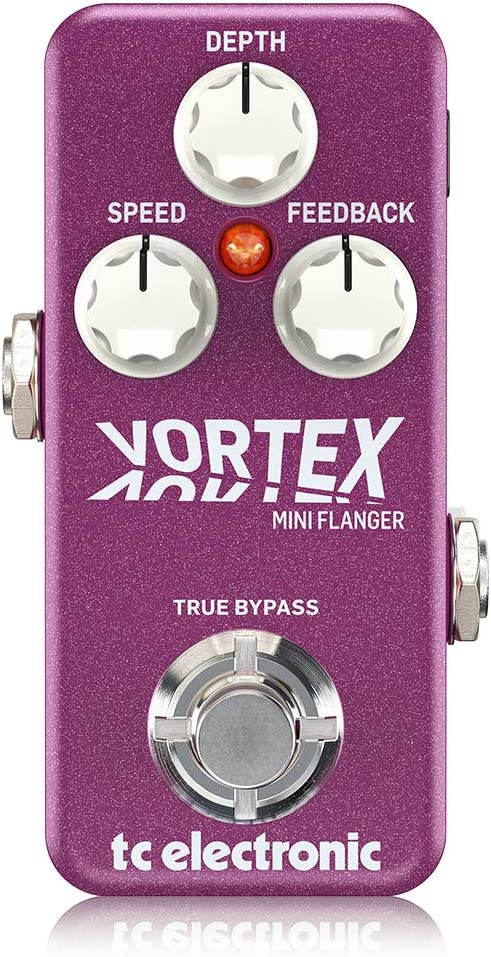
At its core, the Vortex Mini Flanger from TC Electronic is a compact, artist-friendly flanger pedal designed to provide users with a versatile range of sounds.
This pocket-sized pedal is equipped with TonePrint technology, which lets you upload tones from your favorite artists to the device.
It also features the iconic ‘through-zero-flanger,‘ which offers the unique, psychedelic tones of the 1960s.
Despite its small size, this pedal offers significant flexibility in setup.
It can be an inline effect or part of your amp’s loop.
In addition, analog dry-through capability ensures your tone remains untouched when the pedal isn’t used, while true bypass guarantees a clean signal path.
With the accompanying free TonePrint Editor, you can shape the pedal’s sound to your liking.
Besides, this pedal maintains an analog flavor with its true-to-tone feature, granting no loss of tone whether the pedal is engaged.
- My Review
I have to say, the TC Electronic Vortex Mini Flanger took me by surprise.
The first thing I noticed was the small size.
It was a convenient little package that easily found its spot on my already crowded pedalboard.
Though small in stature, this pedal did not compromise performance.
Instead, it’s a handy little flanger that delivers impressive and versatile sounds.
Let’s talk about the TonePrint technology.
This feature is fantastic!
With the ability to load tones from renowned artists onto the device, I could truly tweak the flanger’s sound according to my preference.
Experimenting with this feature was quite an adventure, opening up a world of different tones at my disposal.
Getting that authentic 1960s flanger sound, thanks to the ‘through-zero-flanger,’ was another standout moment for me.
It took me on a nostalgic trip back in time—a big plus for any musician who cherishes the golden age of rock and roll.
One aspect I was slightly critical of, though, was its subtlety.
While I appreciated that the effect wasn’t overly dramatic, there were times when I wished for a more noticeable flanger sound – something more “jet plane-like.” In addition, I would’ve liked a bit more punch when the pedal is activated.
But in the face of such minor drawbacks, the versatility of the Vortex Mini Flanger still shone through.
Connecting the pedal to my amp’s input or loop path offered flexibility in shaping my overall sound.
Finally, the pedal’s true bypass and analog-dry-through features proved true to their word.
My dry signal retained its character, unaffected by whether the pedal was on or off, ensuring that my original tone was always preserved.
Here are the ratings I’ll give to the TC Electronic VORTEX Mini Flanger Pedal:
The Vortex Mini Flanger is a compact yet potent flanger pedal that offers more than meets the eye.
It’s a reliable addition to any pedalboard, making it a worthy consideration for those seeking a capable, versatile flanger.
- Pros:
- Compact size
- TonePrint capability
- Customizable flanger sound
- True bypass and analog-dry-through
- Cons:
- Subtle flanger effect
- Possible tone loss with certain setups
My final verdict is that the TC Electronic Vortex Mini Flanger is a highly capable and compact pedal with impressive features and versatile tone options.
It offers a range of customizable flanger sounds and the convenience of TonePrint technology.
The true bypass and analog-dry-through design ensure optimal tonal integrity.
While some users found the flanger effect subtle and experienced potential tone loss in certain setups, overall, the pedal delivers excellent performance.
The TC Electronic brand is well-regarded, and considering its features, performance, and value for the price, the Vortex Mini Flanger is a solid choice for guitarists seeking a compact and versatile flanger pedal.
Wampler Tumnus V2 Overdrive & Boost Pedal
Versatile, legendary overdrive tone in a compact package.
Wampler’s Tumnus V2 is a small overdrive and boost guitar effects pedal providing the legendary tone of a much larger, expensive circuit. It offers 3 streamlined control knobs for quick tone-shaping, allowing for a stand-alone OD, pre-gain boost, or buffer use.
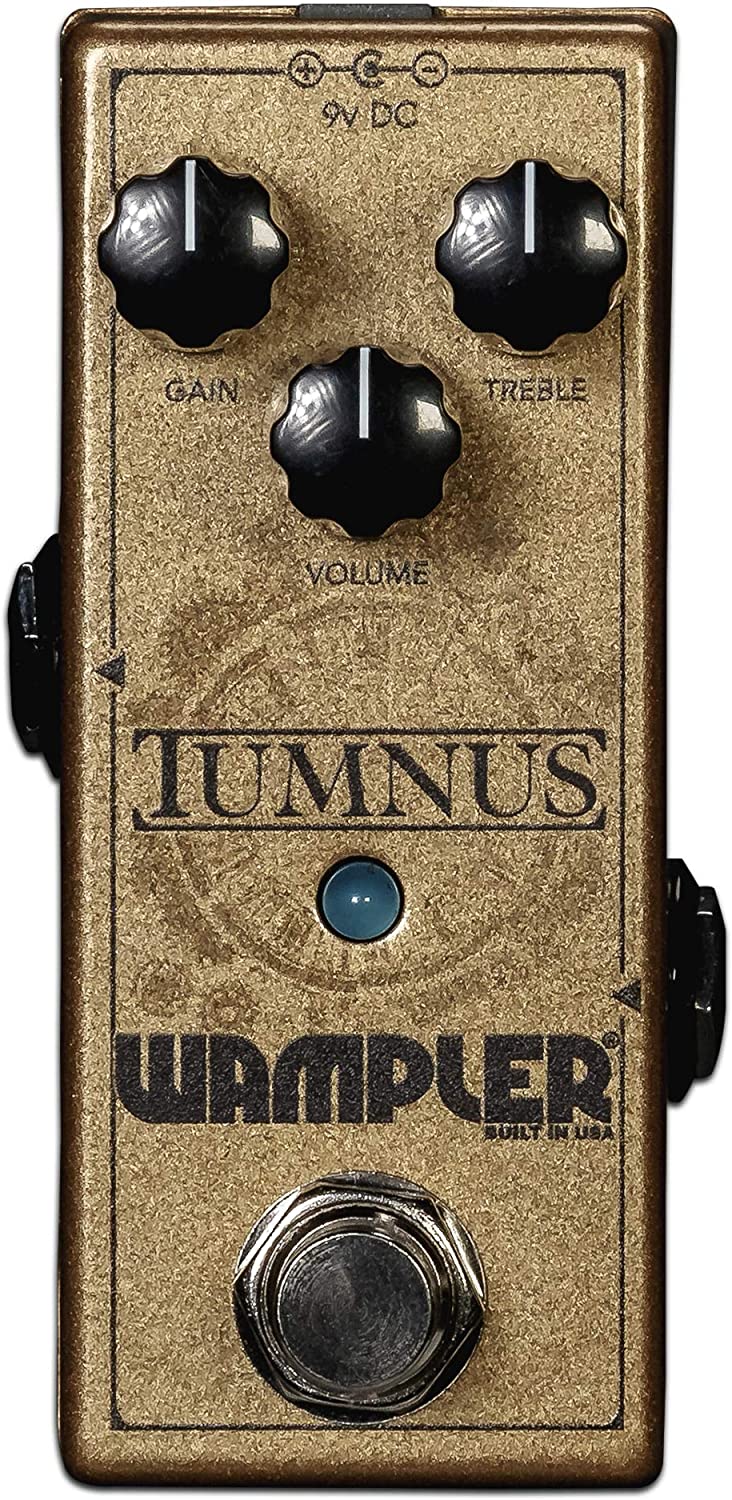
Stepping onto the scene with a fresh, compact look, the Wampler Tumnus V2 is an overdrive and boost guitar effects pedal that can flexibly adapt to any setup and style.
It’s not just an ordinary overdrive pedal.
You can use it to mold your total gain with other pedals, drive it solo for a distinct overdrive, or subtly add a dirty boost to push your amp’s front end.
Interestingly, the Tumnus V2 doesn’t operate on true bypass.
Instead, it possesses a legendary buffered bypass tone, offering its unique appeal.
Its design boasts three streamlined control knobs – Volume, Gain, and Tone – enabling quick and efficient tone adjustment for any gig.
Don’t worry about fitting it onto your pedal board, either.
Its slender dimensions of 7 x 4 x 7 inches and lightweight nature (just 0.2 kilograms) make the Tumnus V2 a space-saving powerhouse for your setup.
Crafted by Wampler, it embodies functionality and style packed into a compact size.
- My Review
When I took the Wampler Tumnus V2 out of its packaging, I could tell it was a gear ready to elevate my sound.
True to its promise, it effortlessly adapted to my setup, offering a unique, versatile sound no matter how I chose to employ it.
It wasn’t just an overdrive.
There was something genuinely magical about how the Tumnus V2 shaped my total gain.
Whether I used it to add a dirty boost to my amp or let it take center stage as a stand-alone overdrive, it exuded an entirely original character.
The Tumnus V2 doesn’t operate on a true bypass unlike many other pedals.
Instead, it channels a buffered bypass tone, which is legendary in the guitar world.
This peculiarity gives the Tumnus V2 a unique tonal color that sets it apart.
With three streamlined control knobs—Volume, Gain, and Tone—I quickly dialed in the sound I was after.
These intuitive controls allowed me to make precise adjustments, delivering the exact tones required for every gig.
Of course, the slim design was the cherry on top.
Weighing just 0.2 kilograms and measuring 7 x 4 x 7 inches, the Tumnus V2 is compact yet robust.
It fits effortlessly onto my pedal board, adding considerable firepower without taking up much space.
However, it wasn’t all roses.
There were times when I wished the pedal had a touch more tonal variation, particularly with the boost function.
It could also get a bit noisy at higher gain settings, which may prove bothersome for those who prefer silent operation.
Here are the ratings I’ll give to the Wampler Tumnus V2 Overdrive & Boost Pedal:
But despite these few gripes, I found the Wampler Tumnus V2 to be an exceptional overdrive and boost pedal.
It’s not just a pedal; it’s a veritable tone sculptor that’ll lend a distinctive edge to your sound.
- Pros:
- Versatile and adaptable to any setup
- Compact design fits well on pedal boards
- Streamlined control knobs for easy tone adjustment
- Can be used as a standalone overdrive or boost
- Provides a clean and smooth distortion
- Cons:
- Potential noise issues when gain is high
- Switching mechanism may be less sturdy
- Some users find it lacking in tonal variation
My final verdict is that the Wampler Tumnus V2 Overdrive & Boost Guitar Effects Pedal is a highly versatile and feature-packed pedal that delivers excellent tone and performance.
Its adaptability, compact design, and streamlined controls have received positive reviews.
While some users have reported potential noise issues and a less sturdy switching mechanism, it offers great value for its price overall.
With its dynamic response and the possibility of achieving a Klon-like sound, the Tumnus V2 is a solid choice for guitarists looking for a versatile overdrive and boost pedal.
MXR Phase 95 Mini Guitar Effects Pedal
Iconic phase circuits in a mini MXR pedal for superior sound.
The MXR Phase 95 combines two classic phasing circuits in a mini housing, allowing for subtle two-stage and more pronounced four-stage phasing. The script switch toggles between two phasing styles, and the familiar speed control sets the rate of the effect. Perfect for tight pedalboard setups.
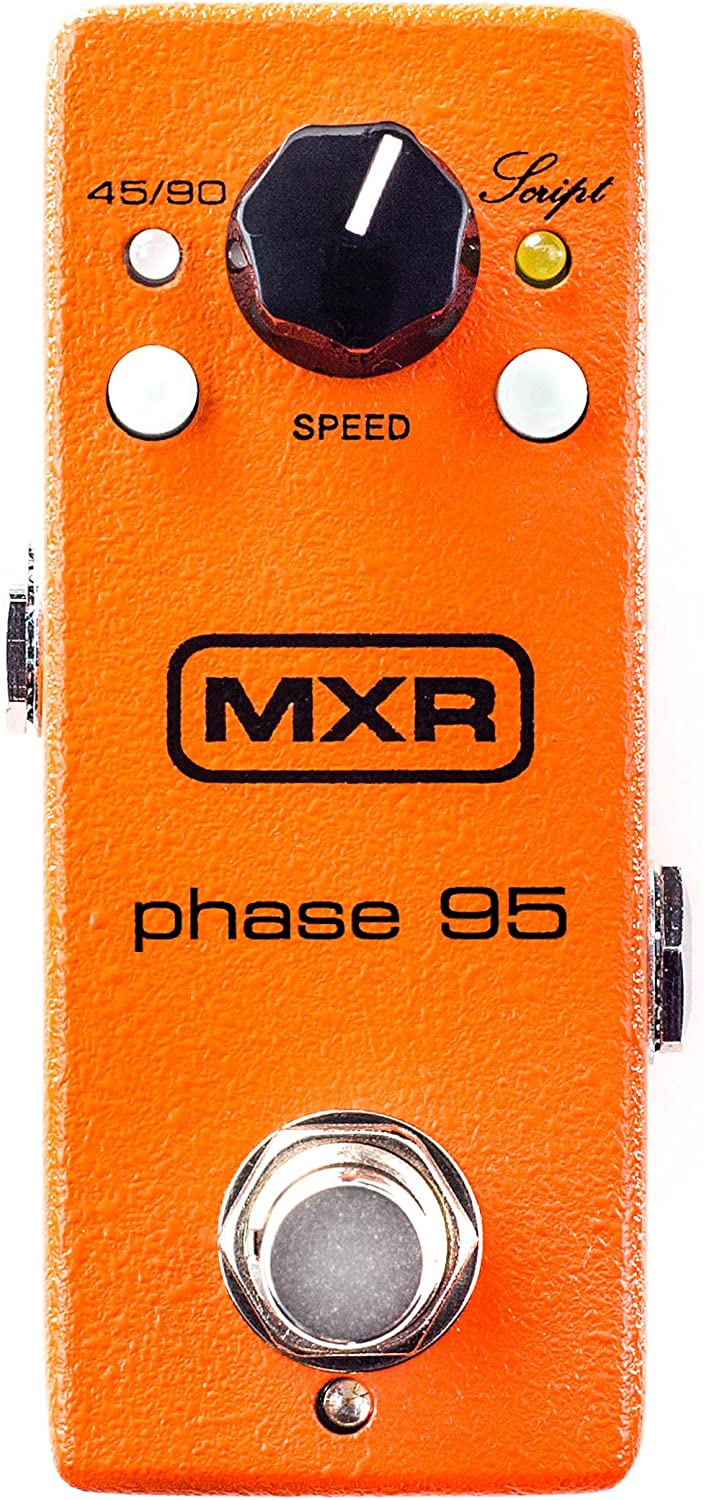
Get to know the MXR Phase 95 Mini Guitar Effects Pedal, a cleverly designed, compact device created by JIM DUNLOP.
This petite powerhouse houses the most recognized phasing circuits of MXR, a reputable Rochester-based effects pedal manufacturer with roots stretching back to 1972.
It’s a real space-saver, being half the size of an average MXR pedal.
In addition, it offers flexibility with its 45/90 switch, which lets you flip between the distinct phase 45 and phase 90 circuits, altering your sound to your preference.
One of its unique characteristics is the script switch.
This neat feature enables musicians to select between a modern phasing approach and a more traditional, subtle vintage vibe by taking out feedback.
Please take note, it doesn’t come with an adapter.
With a multicolored exterior and a compact size measuring 5.5 x 4.5 x 3 inches, it weighs only half a pound.
The model number for this beauty is M290.
It’s not just a pedal – it’s an evolution of sound in a compact package.
- My Review
Stepping on the MXR Phase 95 Mini Guitar Effects Pedal, I felt like I’d stumbled upon a hidden treasure.
This compact marvel from JIM DUNLOP holds up to its promise, delivering a powerful performance in a petite package.
In addition, it surprised me just how seamlessly it combines MXR’s hallmark phase circuits.
Imagine having that classic, iconic MXR sound, all housed within a unit half the standard size – talk about efficiency!
Having the versatility to switch between phase 45 and phase overall performance, but also for its petite and convenient form factor.
One moment, I found myself submerged in the smooth and mellow vibes of the Phase 45 circuit, and the next, I was riding the wave of more pronounced tonal shifts with the Phase 90 setting.
The removal of feedback using the Script switch revealed an entirely new sound landscape for me.
This pedal allowed me to venture back in time, offering a more subdued, classic tone that brought back the nostalgic sounds of yesteryears.
In contrast, the switch met my needs when I craved a modern, rich phasing style.
Although I was slightly put off by the absence of an adapter in the package, I feel this shortcoming does not significantly detract from the value that Phase 95 offers.
Instead, it’s a minor inconvenience, considering this pedal’s expansive range of sonic possibilities.
Painted in vibrant hues, it’s a visual delight, not to mention impressively lightweight and portable.
Despite its diminutive size, it was more than capable of delivering a weighty punch to my music.
My experience with the MXR Phase 95 Mini Guitar Effects Pedal, or the M290 as they call it, was nothing short of a revelation.
Here are the ratings I’ll give to the MXR Phase 95 Mini Guitar Effects Pedal:
It isn’t just a mere accessory; it’s a transformative tool for any musician wanting to explore new dimensions of sound.
In addition, I find it’s a testament to the innovation and creativity that JIM DUNLOP continuously brings to the table.
- Pros:
- Compact size
- Combines iconic phase circuits
- Switch for vintage or modern phasing
- Cons:
- No adapter included
My final verdict is that the MXR Phase 95 Mini Guitar Effects Pedal is an excellent choice for guitarists seeking a compact and versatile phaser pedal.
Its combination of iconic phase circuits, switchable vintage or modern phasing, and solid performance delivers a wide range of tones.
Although it doesn’t include an adapter, its overall brand reputation and the value it offers make it a compelling option for musicians.
Pigtronix PTM Guitar Compression Pedal
Noiseless, clean sustain with parallel compression and treble EQ.
The Pigtronix Philosopher’s Tone Micro offers noiseless clean sustain, blend control for parallel compression, and treble EQ for boost or cut at 2kHz. Its internal 18V power offers maximum headroom while the true bypass switching ensures no tone coloration.
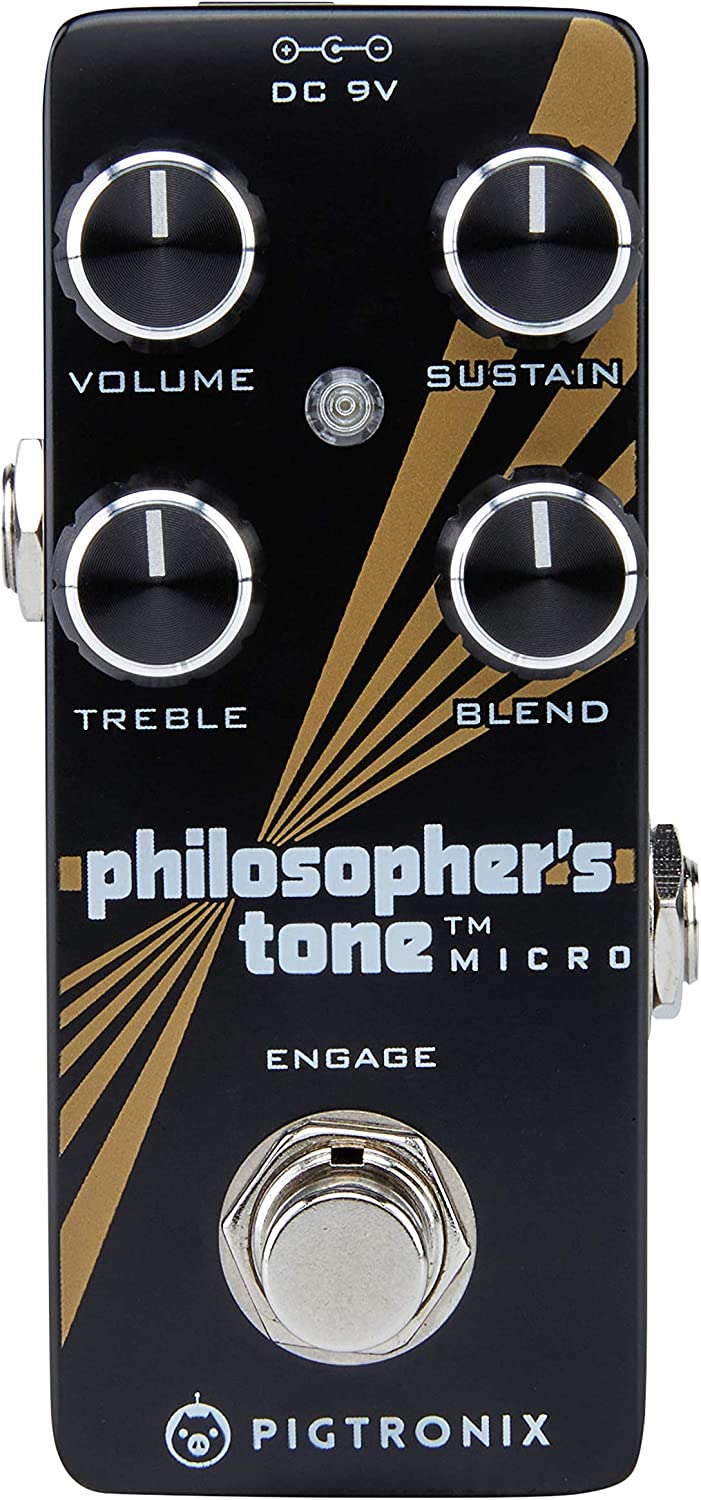
Bringing the magic of a versatile guitar effect to your fingertips, the Pigtronix Philosopher’s Tone Micro, an all-black guitar compression effects pedal, packs a punch in a compact package.
Renowned for generating a noiseless and clean sustain, it stands out in the world saturated with compression pedals.
Its unique ability allows musicians to blend their original tone with the compressed sound effect, thanks to its parallel blend knob.
This feature retains the natural pick attack, even with extreme sustain settings.
Adding to its user-friendliness, a treble EQ lets you fine-tune the frequency response.
Even better, this nifty device doesn’t compromise on the power aspect.
It operates on a standard 9V external power source but boasts an internal 18V power supply for maximum headroom.
You do not forget its true bypass switching ability and compact size, perfect for your pedal board.
- My Review
Diving right into it, the Pigtronix Philosopher’s Tone Micro, this compact black guitar compression effects pedal, surprised me in more ways than one.
Don’t be deceived by its size – it’s a small powerhouse that creates an exceptionally clean, noiseless sustain.
This functionality sets it apart from an array of compressor pedals, making it a distinctive choice.
Testing the parallel Blend knob, I brought together my instrument’s original tone with the compressed sound effect.
This function maintained the natural pick attack, even when pushing the sustain settings to their limit.
This struck me as a valuable feature for any player wanting to retain the authentic sound of their guitar.
I particularly appreciated the Treble EQ.
Adjusting it allowed me to fine-tune the frequency response up to a 6db cut or boost at 2KHz. This broadened the range of sounds I could achieve, whether seeking a rich, warm sound or something more punchy and bright.
Where power is concerned, it operates with a standard 9V external power but also has an internal 18V power supply.
This gave it maximum clean headroom, even when using hotter pickups and line-level signals.
What stood out for me was the pedal’s true bypass-switching capability.
This feature meant my guitar signal wasn’t impacted when the effect was off, which was a big plus.
However, as much as I admire this pedal, it did have a few quirks.
There’s an audible pop when engaging the pedal, which is common with true bypass but can be irritating.
Here are the ratings I’ll give to the Pigtronix PTM Guitar Compression Pedal:
Also, the effect can feel excessively strong, even at the lowest sustain setting, which might not suit players seeking a subtle compression effect.
But despite these small issues, it’s a hard-working pedal that shines in its unique features and adaptability.
- Pros:
- Noiseless clean sustain
- Parallel compression with Blend control
- Treble EQ for boost or cut at 2kHz
- Runs on standard 9V external power
- Compact size: 3.75 x 1.5 x 1.75 in.
- Cons:
- Some users found the tone lacking
- Compression engagement may sound abrupt
- May not bring in an unaffected signal for some
My final verdict is that the Pigtronix Guitar Compression Effects Pedal is a versatile and feature-rich option with a solid performance.
It offers noiseless clean sustain, parallel compression with blend control, and a treble EQ for tone shaping.
The compact size and standard 9V power make it convenient for guitarists.
While some users found the tone lacking and the compression engagement abrupt, the overall brand reputation and value are positive.
Considering its strengths and weaknesses, I recommend the Pigtronix Guitar Compression Effects Pedal to guitarists looking for a versatile compression pedal with good features and performance.
MXR Carbon Copy Mini Analog Delay Pedal
MXR Carbon Copy Mini: Compact, warm analog delay for any player.
MXR Carbon Copy Analog Delay offers a warm, rich Bucket-Brigade sound in a compact, easy-to-use pedal. Perfect for guitarists looking for a versatile delay effect, it’s suitable for both studio and live performance.
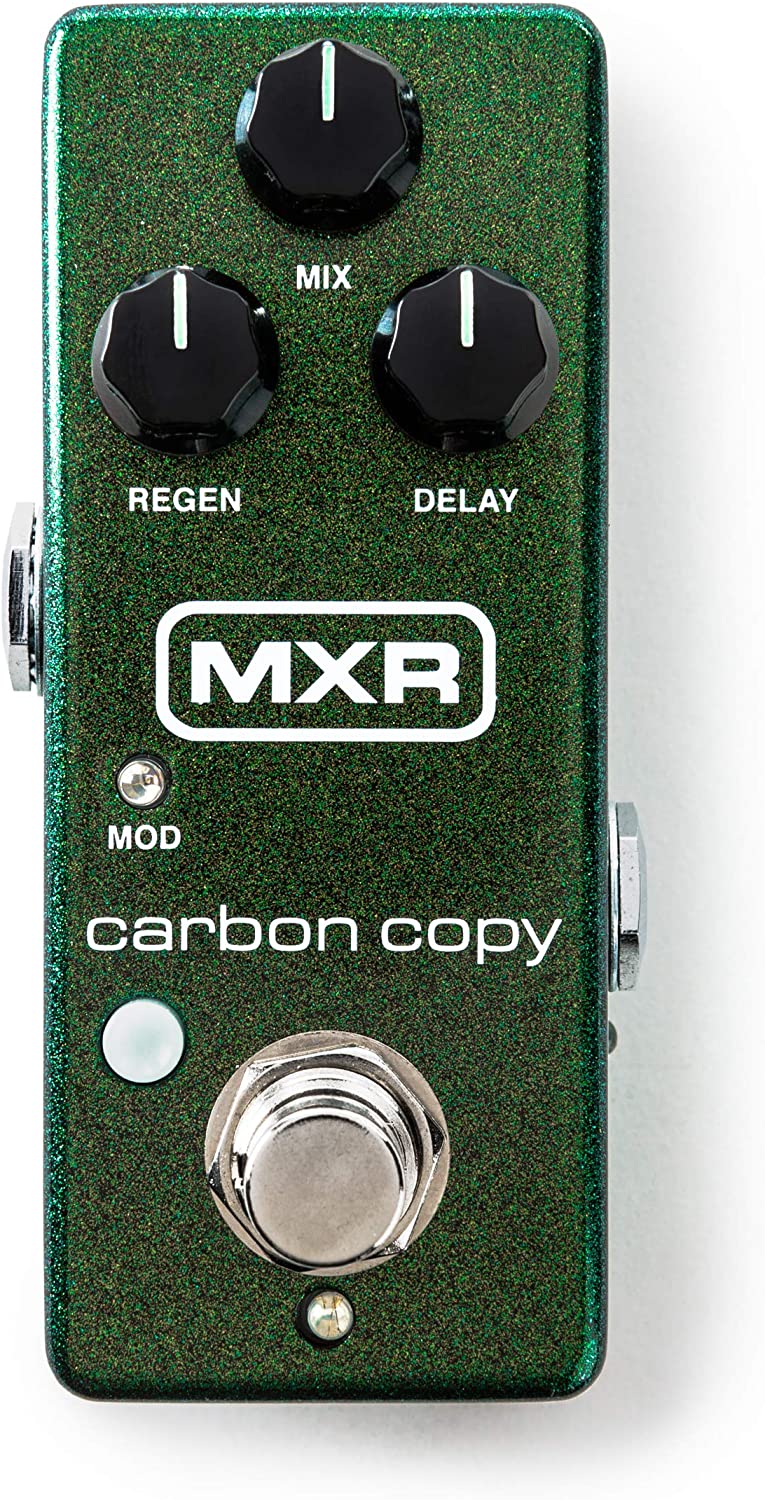
With a name like the MXR Carbon Copy Mini Analog Delay Effects Pedal, you might imagine a device that packs a punch in a compact format.
You’d be right. This little powerhouse offers up to 600ms of delay time, featuring a Modulation Switch and a Bright Toggle.
The style? It’s a fusion of delay, mini, and modulation.
Donned in a carbon color, its small frame measures just 3.56 x 1.75 x 2 inches and weighs a mere 0.5 pounds.
Despite its diminutive size, this pedal has gained popularity among professionals and hobbyist guitarists for its exceptional sound and user-friendly interface.
MXR, a New York-based company renowned for its effects pedals, is behind this rock ‘n’ roll essential.
The Carbon Copy series has held a strong presence in the music scene for over a decade.
But, if you want to conserve space on your board or require a travel-friendly option, this mini version checks the box.
An extension of the larger Carbon Copy line, it carries on the tradition of the analog delay warmth and simplicity that many have come to love.
- My Review
After spending time with the MXR Carbon Copy Mini Analog Delay Effects Pedal, I was struck by its potent performance within such a compact build.
This gadget is far from the average effects pedal – it’s a bona fide jack-of-all-trades for musicians seeking a sturdy, reliable, easy-to-use delay pedal.
Don’t let the size fool you; its miniature frame doesn’t compromise on the versatility of sound.
There’s an impressive delay time of up to 600ms that adds a well-rounded richness to the sound output, all served up with an analog warmth that’s quite hard to replicate.
The Modulation Switch and Bright Toggle offer great control, allowing you to tweak the pedal’s output to match your preferred tonal characteristics.
For example, I appreciate the toggle’s ability to switch from a deep, lush echo to a more prominent, brighter delay.
When it comes to design, it scores high marks for its sleek carbon-colored exterior and ergonomic dimensions.
In addition, this pedal doesn’t occupy much space on your pedalboard, making it an ideal choice for those who like to keep things tidy or who need to travel light.
Despite its relatively small size and weight, its sturdy feel reassured me of its durability.
In addition, its user-friendly nature and top-notch sound quality make it a real contender in delay pedals.
Here are the ratings I’ll give to the MXR Carbon Copy Mini Analog Delay Pedal:
What truly sets this pedal apart is how it stays true to MXR’s legacy of creating high-quality effects pedals.
It beautifully echoes the analog delay warmth and simplicity of its predecessors from the Carbon Copy series, making it more than just a downsized version – it’s an integral part of a well-loved tradition.
- Pros:
- Warm and rich analog delay sound.
- Compact size for portability.
- Modulation switch for added versatility.
- Cons:
- Limited delay time (600ms).
- No tap tempo function.
My final verdict is that the MXR Carbon Copy Mini Analog Delay Effects Pedal is an excellent choice for guitar players seeking a compact and versatile delay pedal.
Its warm analog delay sound, modulation switch, and compact size offer great features and portability.
In addition, the brand, MXR, has a reputable history in the industry, further adding to the pedal’s credibility.
While it may have some limitations, such as the relatively shorter delay time and the absence of a tap tempo function, it delivers a solid performance and offers good value for its price.
JHS Mini Foot Fuzz Effects Pedal
Classic and modern high-gain buzz in a tiny, easy-to-use package.
The JHS Mini Foot Fuzz V2 is a small but powerful fuzz guitar effects pedal which offers a range of vintage-style and modern high-gain tones. It features Volume and Fuzz controls and a +/- switch for added versatility. JHS Pedals are renowned for their quality and performance.
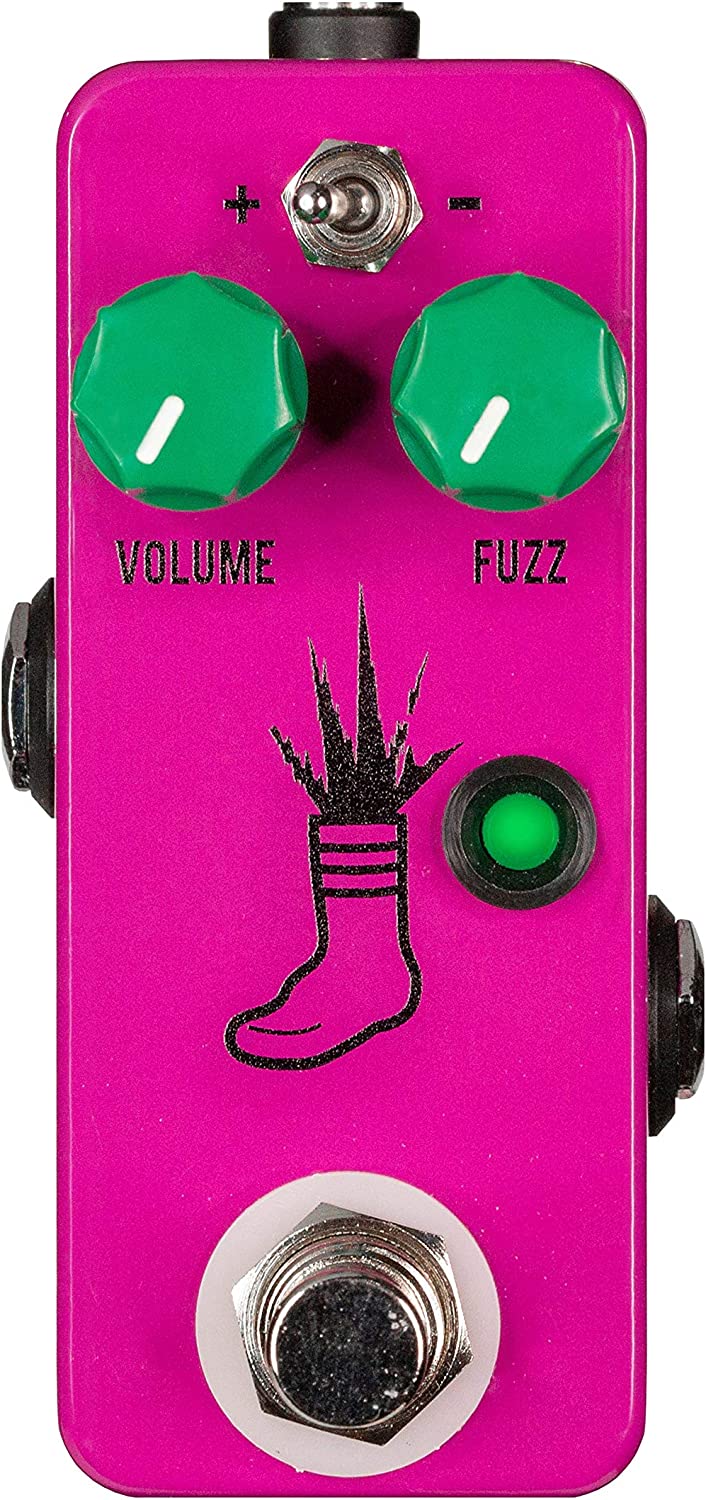
Meet the JHS Mini Foot Fuzz V2, a compact and formidable guitar effects pedal.
While its size might suggest otherwise, this pedal is no joke; it’s a powerful sound manipulator, perfect for musicians seeking an array of fuzz tones.
With simple controls – Volume, Fuzz, and a gain switch – it’s a breeze to operate.
Dial back the Fuzz, crank up the Volume, and get some low-gain, old-school fuzz tones.
As you increase the Fuzz setting, you’ll discover a spectrum of edgy and sputtery tones, ideal for standout riffs or powerful leads.
The gain toggle switch further expands its versatility.
In the minus position, it mimics the unique sound of a vintage, busted speaker.
Switch it to plus, and prepare for a high-gain onslaught that can rock any venue.
And remember, all this power and flexibility comes from a pink, foot-sized device.
This petite powerhouse of a pedal encapsulates a whole lot of attitude in a little package.
- My Review
Stepping into the spotlight, I was accompanied by the JHS Mini Foot Fuzz V2, a compact guitar effects pedal.
Its playful, pink exterior belies the beast within – a beast that, once unleashed, provides a spectrum of sound that ranges from the subtlest hint of fuzz to an all-out, roof-shattering buzz.
From the first strum, its character was apparent.
Subtly turning the Fuzz knob brought forth the soft splatter of low-gain fuzz reminiscent of classic, vintage tones.
It felt like I had uncovered a time capsule from the golden era of rock ‘n’ roll.
Venturing further, I nudged the Fuzz control towards its maximum, and it was like opening Pandora’s Box.
A cascade of cutting, sputtering tonnes sprang forth, each itching to embed itself into a powerful riff or screaming lead line.
It felt raw, raucous, and wonderfully unhinged.
But this pedal isn’t all about being loud and proud.
Instead, its versatile nature shines through when engaging the toggle switch.
In its minus position, it faithfully recreates the eccentric charm of a broken speaker – crackling, sputtering, and fizzling with vintage authenticity.
Flip the switch to plus, however, and it becomes an entirely different animal, generating a high-gain buzz so intense it seemed to have the potential to raise the dead.
The JHS Mini Foot Fuzz V2 is more than just a guitar pedal.
It’s a sound alchemist’s dream, transforming the most mundane tones into sonic gold.
However, a word of caution: This pedal, with its potential for such a vast tonal range, might seem daunting to novices.
Here are the ratings I’ll give to the JHS Mini Foot Fuzz Effects Pedal:
It demands experimentation and a good understanding of how fuzz tones work.
So, if you’re ready to dive, you might find yourself amid an aural adventure like no other.
- Pros:
- Versatile with a wide range of tones.
- Simple and easy-to-use controls.
- Offers both low-gain and high-gain settings.
- Compact size for convenience and portability.
- Cons:
- No specific cons identified.
My final verdict is that the JHS Mini Foot Fuzz V2 Fuzz Guitar Effects Pedal is a highly versatile and user-friendly pedal that offers a wide range of tones.
With simple controls and the option to switch between low-gain and high-gain settings, it provides a convenient and portable solution for guitarists seeking vintage-style fuzz and modern high-gain buzz.
In addition, the compact size adds to its appeal.
Based on the information provided, no specific cons were identified.
This pedal is a promising choice for musicians searching for a reliable and versatile fuzz effect.
MXR Duke of Tone Overdrive Pedal
A pedal with warmth, grit, and versatile output.
This unique collaboration between MXR and Analog Man delivers a pedal that adds warmth and grit, while preserving the characteristics of your high-end gear. Featuring thru-hole components tested by Analog Mike himself, this pedal includes a Boost/OD/Distortion switch to tailor the output attitude. Experience a pedal that allows your signal chain’s nuances to shine through, from strings to amp tubes.
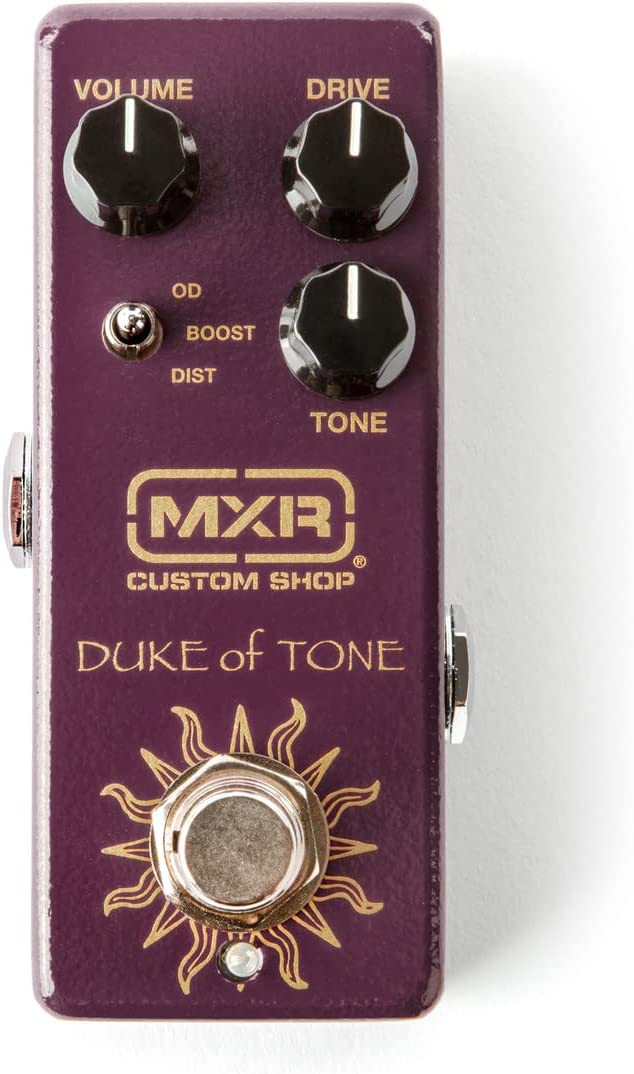
The MXR Duke of Tone Overdrive is the offspring of a creative partnership between MXR and Analog Man.
It’s a stellar pick for musicians seeking to infuse their music with a touch of grit and warmth while maintaining the authenticity of their instrument’s tone.
This compact, purple pedal offers an interesting blend of old and new – it has vintage attributes, appealing to tone purists, but is also packed with modern features.
For instance, Analog Mike has personally validated its thru-hole components, giving it bespoke quality.
It boasts a straightforward control interface with volume, drive, and tone knobs.
Additionally, it comes with a Boost/OD/Distortion switch that adjusts the pedal’s overall output.
Finally, its operation at 18 volts ensures sufficient headroom and clarity, even in Boost mode.
- My Review
Having spent some time with the MXR Duke of Tone Overdrive, I’ve grown to appreciate its flexibility and unique sound.
It’s a compact powerhouse that combines grit, warmth, and clarity, effortlessly enhancing the natural tone of my high-end gear without overpowering it.
I immediately noticed that the Duke of Tone had been meticulously crafted.
The thru-hole components are tested by Analog Mike himself, instilling a certain vintage charm.
But it’s not just about nostalgia; these components’ sound quality is impressive, giving that warm yet clear, open sound that lets the nuances of my gear shine through.
What’s notable about the Duke of Tone is its straightforward control interface.
With Volume, Drive, and Tone knobs, I can quickly and easily tweak the sound to fit my mood.
No fuss, just simple adjustments that result in dramatic changes in tone.
Now let’s talk about the Boost/OD/Distortion switch.
What a game-changer!
This little switch has allowed me to experiment with different attitudes toward the pedal’s output.
Be it the vigorous push of the Boost mode, the grit and compression of the OD, or the slight increase from the Distortion mode, each has its charm.
Powering it at 18 volts has added an interesting dynamic.
I noticed a significant boost in headroom and clarity, particularly in Boost mode.
It was a pleasant surprise, and I found it quite useful when I wanted my sound to carry just a bit more weight.
But here’s a bit of honesty.
While the Duke of Tone is an excellent pedal, it didn’t drastically outperform my other overdrive pedals.
Nevertheless, it has found a well-deserved spot on my pedalboard for its remarkable versatility and distinctive sound characteristics.
Here are the ratings I’ll give to the MXR Duke of Tone Overdrive Pedal:
If you’re in the market for a pedal that enhances your tone and offers a fair share of experimentation, you’ll find a faithful friend in the MXR Duke of Tone Overdrive.
But it might not be an essential purchase if you’ve already got a fully stocked arsenal of overdrive pedals.
- Pros:
- Warm and gritty tone.
- Preserves natural sound and feel.
- Versatile for different genres.
- Cons:
- May not offer significant differentiation from other overdrive pedals.
- The distortion mode may not provide the expected level of distortion.
My final verdict is that the MXR Duke of Tone Overdrive is a highly versatile and well-performing pedal with a warm and gritty tone.
It offers a range of features, including a Boost/OD/Distortion switch, and effectively preserves the natural sound and feel of high-end gear.
The collaboration between MXR and Analog Man brings credibility to the brand, and the overall value of the pedal is commendable.
While it may not differentiate significantly from other overdrive pedals, it still delivers a satisfying performance.
Ultimately, the MXR Duke of Tone Overdrive is a solid choice for guitarists seeking to add warmth and character to their rig.
What exactly is a mini guitar pedal?
A mini guitar pedal is a compact, space-saving version of a traditional guitar effect pedal, designed to provide a range of guitar effects while occupying less space on a pedalboard.
These miniature devices have gained popularity among guitarists over the past few years due to their portability, affordability, and impressive performance compared to their larger counterparts.

Mini guitar pedals offer the same functionality as standard-sized pedals, allowing guitarists to shape their guitar tones according to their desired sound, style, and genre.
In addition, they can deliver various effects, such as distortion, overdrive, reverb, delay, modulation, and even intricate looping capabilities, all in a small, pedalboard-friendly package.
The smaller footprint has several advantages, although size is the primary difference between mini and standard-sized guitar pedals.
First, since they occupy less space, guitarists can fit more pedals onto their pedalboards, enabling them to experiment with a wider array of effects and create complex, unique sounds.
Moreover, mini guitar pedals are generally lightweight, making transport and setup much easier for musicians.
Despite their compact nature, mini guitar pedals do not usually compromise sound quality or performance.
Technological advancements in recent years have created mini pedals that can produce equivalent sound quality to their larger counterparts.
High-quality mini pedals utilize excellent circuitry and components to deliver consistent and solid performance.
Consequently, even professional guitarists may find that these compact pedals satisfy their tonal requirements without taking up valuable real estate on their pedalboards.
Furthermore, mini guitar pedals can be more affordable than standard-sized pedals.
While the price of a mini pedal depends on its brand, components, and type of effect, some models can be budget-friendly alternatives to their larger versions.
This affordability factor makes mini guitar pedals enticing for beginners and experienced players looking to expand their effects collection without breaking the bank.
Mini guitar pedals are also compatible with various instruments, not just guitars.
While certain effects may be explicitly tailored for guitar frequencies, many mini pedals can produce satisfactory results with other instruments such as bass or keyboards.
However, it is essential to research compatibility with various instruments or seeks advice from experienced musicians who have successfully used pedals on alternative instruments.
Choosing the best mini guitar pedal for one’s needs entails considering the desired effects, budget, sound quality, and available pedalboard space.
Additionally, since each player may have different personal preferences and requirements, researching each pedal’s performance and sound quality can be vital to finding the perfect fit.
Reading online reviews and watching demo videos can offer valuable insights into various mini guitar pedals’ unique qualities and capabilities.
Furthermore, trying out mini pedals in person (when possible) can help guitarists select the one that works best for their playing style and tonal preferences.
What should you consider when choosing a mini guitar pedal?
When searching for the perfect mini guitar pedal, it’s essential to consider various factors that will influence the effectiveness and practicality of your investment.
The ideal mini pedal should be tailored to suit your playing style, musical preferences, and budget constraints.
The following aspects are vital when choosing the right mini guitar pedal for your setup.
– Sound quality
Sound quality is the most critical factor when choosing any guitar effect pedal, mini or otherwise.
A high-quality pedal should deliver a clean, accurate, and consistent signal that enhances your guitar’s natural tone rather than diminishing it.
Before selecting a mini pedal, ensure that it reproduces your desired effects without introducing noise, artifacts, or loss of signal fidelity.
Take your time to research the available options on the market and listen to audio samples or watch demo videos to assess each product’s sound quality genuinely.
Then, try the mini pedals at a local music store to gauge their sound quality and tonal character to ensure they align with your musical preferences and requirements.
– Controls and features
Mini guitar pedals typically boast a simplified interface with fewer knobs and controls than their full-sized counterparts.
This streamlined design saves space and maintains a minimal footprint on your pedalboard.
Despite this, an excellent mini pedal should provide sufficient controls for intuitive and versatile tone shaping.
Think carefully about the features you will need from your mini guitar pedal and opt for a model with easy-to-understand and manipulated controls.
Be mindful that some mini pedals might sacrifice certain features or functions offered by their larger version, so be sure to verify that your chosen mini pedal caters to your desired level of functionality and control.
– Analog vs. Digital
Fundamentally, there are two different types of mini guitar pedals to choose from: analog and digital.
Analog pedals use electronic components and analog circuitry to produce a warm, organic sound often deemed more ‘authentic.’ Digital pedals, on the other hand, use digital signal processing (DSP) to convert your guitar signal into digital data and apply various effects.
Each type has its advantages and disadvantages, depending on your preferences.
For example, analog pedals typically possess a certain warmth and character that digital pedals can’t replicate.
However, digital pedals may confer greater versatility, consistency, and the ability to simulate multiple effects simultaneously.
Ultimately, the choice between analog and digital will depend on your needs, playing style, and the specific tone you hope to achieve.
– Build quality and durability.
Your mini guitar pedal should be built to last, even when weathering constant foot stomps, rig transportation, and studio sessions.
A well-constructed mini pedal should have robust housing, high-quality components, and sturdy footswitches.
Look for pedals made of tough materials such as metal or high-quality plastic, and don’t hesitate to scrutinize product photos or visit a store to examine the construction.
A quality pedal will feel durable and heavyweight, signaling that it can withstand extensive use.
– Presets and versatility
Many musicians appreciate guitar pedals with customizable presets and versatile sound capabilities.
Presets can save time, particularly when swiftly switching between effects onstage or during rehearsal.
Versatility is particularly useful for those with limited pedalboard space who may require multiple effects within a single pedal.
Research and compare mini pedals to determine the level of versatility they offer.
Look for options with an extensive range of adjustable parameters, effect settings, and presets.
In doing so, you’ll ensure that your mini pedal can accommodate a vast selection of sounds and genres, making your investment more valuable and functional.
– Brand reputation
Another vital consideration when choosing a mini guitar pedal is the reputation of its manufacturer.
Established, well-respected brands are known to produce high-quality products that conform to industry standards consistently.
Of course, exceptions do exist, and new companies or boutique builders can create exceptional pedals.
However, choosing a renowned brand tends to generate peace of mind that you settled for a reliable product backed by a robust support system.
– Price and budget
The price of a mini guitar pedal will vary depending on its effect type, components, features, and brand.
Setting a realistic budget allows you to narrow down your choices to find the model that complements your needs without causing financial strain.
Remember that affordable options exist, but don’t be fooled by suspiciously low prices.
More often than not, cost links directly to product quality, and unnecessarily cheap models may prove disappointing.
Conversely, don’t feel pressured to choose the priciest option, as many mid-range mini pedals deliver excellent results at a reasonable price point.
– Reviews and recommendations
As you research your ideal mini guitar pedal, consult reviews and endorsements by professional musicians, peers, and even online communities, such as forums or social media groups.
These user experiences may add tremendous value as you evaluate different pedal options, considering each model’s performance, quality, and popularity.
Insights from other players provide invaluable, real-life feedback on pedals’ functionality, sound quality, and ease of use.
Ultimately, these recommendations will guide you towards a pedal with a proven satisfaction track record.
Do mini guitar pedals compromise on sound quality?
When it comes to mini guitar pedals, one of the most common concerns is whether their compact size compromises sound quality.
However, over the years, significant improvements in pedal design and technology have addressed these concerns, making mini pedals viable and excellent options for guitarists, even those with high standards and expectations for sound quality.
While many factors can impact sound quality, such as components, circuitry, and design, mini guitar pedals today offer excellent sound quality comparable to their larger counterparts, thanks in part to advances in technology and engineering.
The shorter answer to whether mini guitar pedals compromise on sound quality would be no – not necessarily.
However, to appreciate why and how they maintain a high level of sound quality, we must delve into the aspects of mini pedals that contribute to their performance.
– Circuitry and design innovations
The technology behind mini and standard size guitar pedals has come a long way over the years.
Engineers and designers have consistently improved circuit designs to reduce noise and increase signal fidelity.
In addition, while mini pedals often contain a more compact circuit board and layout, technology has evolved where smaller components can perform in tandem with their larger equivalents.
As a result, mini pedals can consistently deliver quality effects without compromising your overall tone or signal.
– High-quality components
High-quality components are critical to achieving optimum sound quality in a guitar pedal.
Many manufacturers use premium-quality electronic components in their mini pedal designs to prevent compromising on sound quality.
Like their fleshed-out counterparts, brand-name and boutique mini pedals typically use solid capacitors, resistors, and switches.
This preserves signal quality, reducing noise, and providing satisfactory audio performance.
– Careful consideration of features and control
When designing mini pedals, an essential approach is determining which features are essential to sound quality and which can be streamlined or omitted.
For instance, many mini pedals contain fewer knobs than larger ones, with the creators selecting the crucial features, honing in on a streamlined tone structure while maintaining sound quality.
A thoughtful balance is achieved between the feature set and footprint size.
– Analog vs. Digital pedals
The debate between analog and digital guitar pedals has persisted for several years, and in the case of mini pedals, it remains a critical consideration.
Analog mini pedals, which many players highly prize for their warmth and organic character, have proven that a smaller package can still provide the classic feel.
However, in recent years, digital mini pedals have also made strides in design and technology to provide impressive sound quality, creating a level playing field between analog and digital pedals, even at this compact size.
With these aspects in mind, it is essential to note that, like standard-sized pedals, not all mini guitar pedals are created equal.
Sound quality may differ by brand, design, components, and circuitry, an aspect that holds for both mini and standard-size pedals alike.
Therefore, guitarists must research diligently, listen to demos, or even physically try mini guitar pedals before deciding.
A well-researched choice should ensure a pedal functions highly without compromising the desired tonal quality.
While some differences in tonal character could prove negligible between equivalent mini and standard-sized pedals, mini-guitar pedals have grown in acceptance, finding favor with professional guitarists who find coequal sound quality with their larger predecessors, all while enjoying the added benefits of space-saving on their pedalboards.
How to order pedals on a pedalboard?
There is no one-size-fits-all approach to ordering pedals on a pedalboard, as the optimal arrangement largely depends on the specific sound you’re aiming for.
Usually, though, you will see guitar players mostly agreeing with this order:
Tuner > Filters/Dynamics > Pitch-based Effects > Overdrive/Distortion > Modulation > Time-based Effects > Looper
Aside from that, some general guidelines can help you achieve a balanced and versatile setup.
Let’s talk in detail about the order we just mentioned, but feel free to experiment and adjust to your own preferences:
- Tuner: Place your tuner pedal first to ensure your signal is in tune before passing through the other pedals.
- Filters and dynamics: Wah-wah, envelope filters, compressors, EQs, and noise gates should come next. These pedals affect your sound’s dynamic and tonal aspects, so it’s best to place them early in the chain.
- Pitch-based effects: Octavers, harmonizers, and pitch shifters should come after filters and dynamics since these pedals alter the pitch of your signal and work best with a clean, unprocessed sound.
- Overdrive and distortion: Overdrive, distortion, and fuzz pedals typically come next. They shape your guitar’s core sound, and placing them before most other effects ensures that those effects receive a strong, consistent signal.
- Modulation effects: Chorus, flanger, phaser, and tremolo pedals should be placed after overdrive and distortion effects. We do this to allow these pedals to add depth and movement to your sound without becoming overly distorted or overbearing.
- Time-based effects: Delay and reverb pedals should be placed towards the end of your signal chain. This allows them to create a sense of space and depth around the other effects, simulating the sound of a room or hall.
- Looper: If you use a looper pedal, it should be placed last in the chain. This ensures that you’re looping the entire signal, including all the effects you’ve applied.
Remember, these are just general guidelines and what generally works and sounds good.
The most important thing is to experiment and find the arrangement that best suits your personal sound and style.
For example, here’s one pedalboard signal chain that I always use:
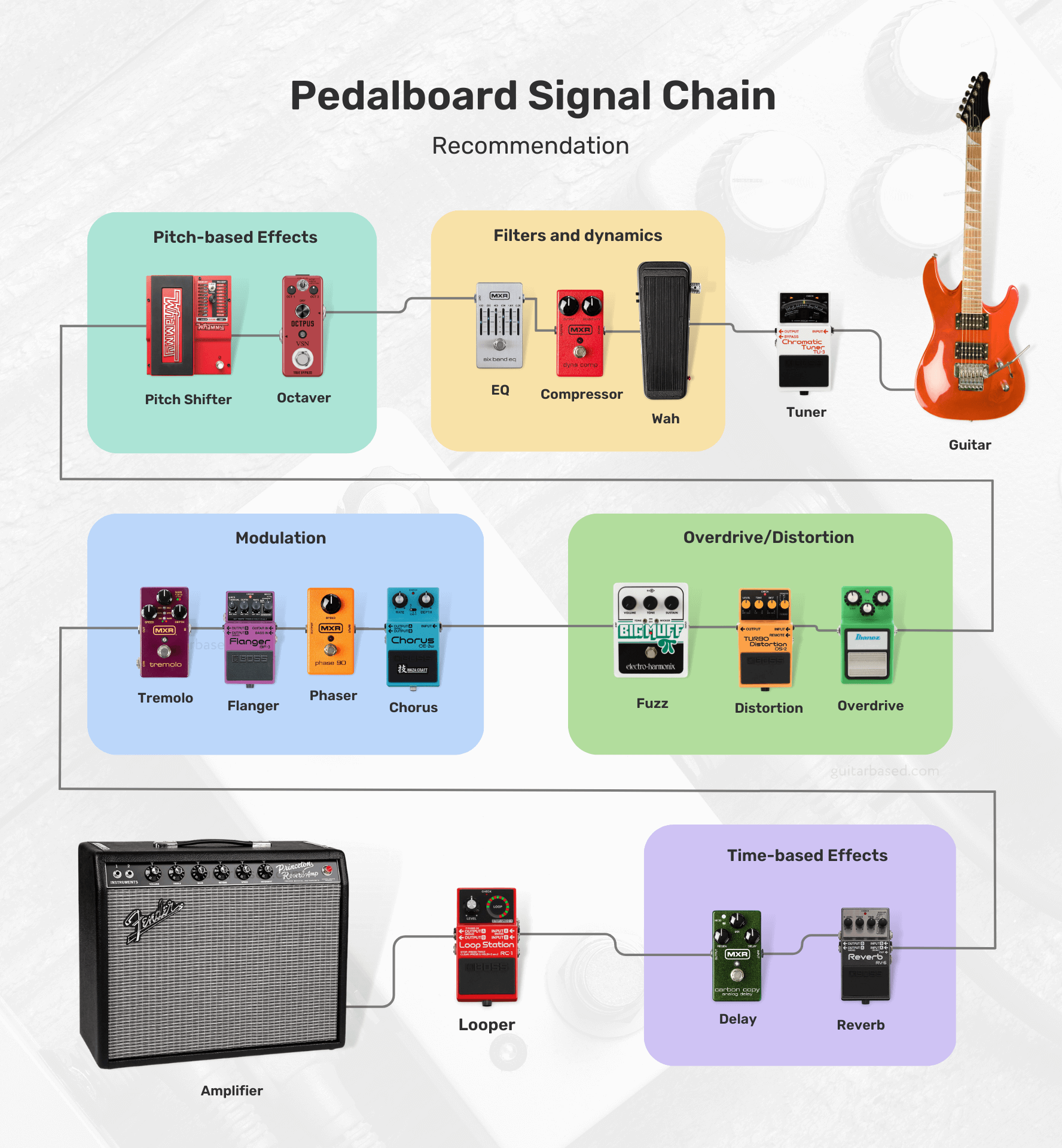
Feel free to swap the order of pedals, try different combinations, and test out unconventional setups until you find the one that works best for you.
For those interested, I’ll leave you with most of the possibilities that you’ll encounter and how to order them.
- Tuner
- Filters/Dynamics:
- Volume
- Wah
- Auto-Wah
- Compressor
- Noise Gate
- EQ (Equalizer)
- Pitch-based Effects:
- Octaver
- Harmonizer
- Pitch Shifter
- Overdrive/Distortion/Fuzz:
- Boost
- Overdrive
- Distortion
- Fuzz
- Modulation:
- Chorus
- Phaser
- Flanger
- Univibe
- Vibrato
- Tremolo
- Time-based Effects:
- Delay
- Echo
- Reverb
- Synth/Bitcrusher:
- Synth
- Bitcrusher
- Acoustic Simulator
- Multi-Effects
- Utility:
- Buffer
- A/B/Y Switcher
- MIDI Controllers
- Looper
Boutique vs. Mass-Produced pedals
Boutique pedals are generally built with higher-quality components and craftsmanship, resulting in better durability and longevity.
These pedals often feature unique and innovative designs, providing a wider range of tones and effects that may not be available in mass-produced options.
Here are a few examples of boutique pedals:

All the manufacturers also tend to have a more personal approach, with better customer service and the ability to customize pedals according to the user’s preferences.
However, boutique pedals are usually more expensive due to the smaller scale of production and the use of premium components.
Mass-produced pedals, on the other hand, are more affordable due to their larger scale of production and the use of cost-effective components.
These pedals are widely available and offer a range of popular effects, making them accessible to a larger audience.
Here are a few examples of mass-produced pedals:

The quality control for mass-produced pedals can vary depending on the brand and model, but many are reliable and offer good value for the money.
As for one of the downsides, you’ll find that mass-produced pedals may not have the same level of uniqueness or innovation as boutique options.
On the other hand, they may not provide the same level of customer service or customization options.
The choice between boutique and mass-produced pedals depends on your personal preferences, budget, and desired sound.
If you’re looking for unique tones, higher-quality components, and a more personal experience, boutique pedals may be the way to go.
But I would say, for those who are on a budget and need access to popular effects, mass-produced pedals might be a better fit.
It’s worth trying out both types to see which best suits your needs and playing style.
How much should you spend on a guitar pedal?
If I were in your position, I would first determine my budget and specific needs before deciding how much to spend on a guitar pedal.
For beginners, it might be more reasonable to start with affordable, mass-produced pedals to explore different effects without spending too much.
Guitar pedals can range in price from around $30 to over $400, depending on the brand, quality, and complexity of the effect.
As your skills and understanding of your preferred tone develop, you can gradually upgrade to higher-quality or boutique pedals.
One thing I would do is consider which effects are essential to your playing style and prioritize purchasing those first.
Allocating a larger portion of your budget to the most important pedals might be a wise choice, especially if you only need a few basic effects.
However, if you require a wide array of effects, you may want to consider more budget-friendly options or multi-effects units.
Keep in mind that higher-priced pedals often come with better build quality, unique features, and improved sound quality.
But I would also say that price is not always directly correlated with quality or suitability for your needs.
Sometimes, a more affordable pedal can deliver the exact sound you’re looking for, while a higher-priced option might not meet your expectations and are only expensive because of the brand reputation.
Can you use a guitar pedal with a bass guitar?
You can certainly use a guitar pedal with a bass guitar.
But it’s crucial to be aware that some guitar pedals may not be specifically designed to accommodate the frequency range of a bass guitar.
This could result in a less-than-ideal performance or an altered tone that might not be what you were expecting.
If you’re feeling adventurous and eager to experiment with your sound, don’t hesitate to connect your guitar pedals to your bass guitar.
This can be a fun way to explore different sonic possibilities, and you might even stumble upon some unique tones that complement your playing style perfectly.
Using a guitar pedal with a bass guitar may not always produce the desired results.
In some cases, the low-end frequencies might be lost, or the effect could sound too harsh or muddy.
To avoid these issues, you could consider looking into pedals that are specifically designed for bass guitars.
These pedals are engineered with the bass frequency range in mind, ensuring that your low-end remains intact and the effect sounds as intended.
In addition to bass-specific pedals, there are also multi-effects processors and pedals that cater to both guitar and bass players, offering a wide range of effects and tonal options.
These versatile units can be a great solution if you play both instruments and want a single device to cover your needs.
How to properly power your pedals?
When it comes to powering your pedals, you want to make sure you’re doing it right to avoid any noise issues or potential damage.
First, check each pedal’s power requirements, which you can usually find in the manual or on the pedal itself.
You’ll want to pay attention to the voltage (usually 9V, 12V, or 18V) and current (measured in milliamps or mA).
Now, you’ve got a few options for powering your pedals.
You can use individual power supplies or batteries for each pedal, but that can get messy and inconvenient.
I’d recommend going for a pedal power supply or an isolated power brick.

For example here are a few ones I recommend:
- Voodoo Lab Pedal Power 2 Plus Isolated Power Supply (My favorite)
- Rowin PW-1 Guitar Pedal Power Supply (Cheapest)
These babies can power multiple pedals at once, and the isolated outputs help prevent noise and ground loop issues.
Just make sure the power supply you choose can handle the voltage and current requirements of all your pedals.
When you’re connecting everything, use good quality power cables and keep them neat and tidy to avoid a tangled mess.
You might even want to use cable ties or cable organizers to keep everything in order.

More than 10 years of experience playing and writing about guitars! When not writing, I can be found strumming away some Johnny Cash tunes. Favorite all time guitar is the Gibson Les Paul. #TeamGibson

